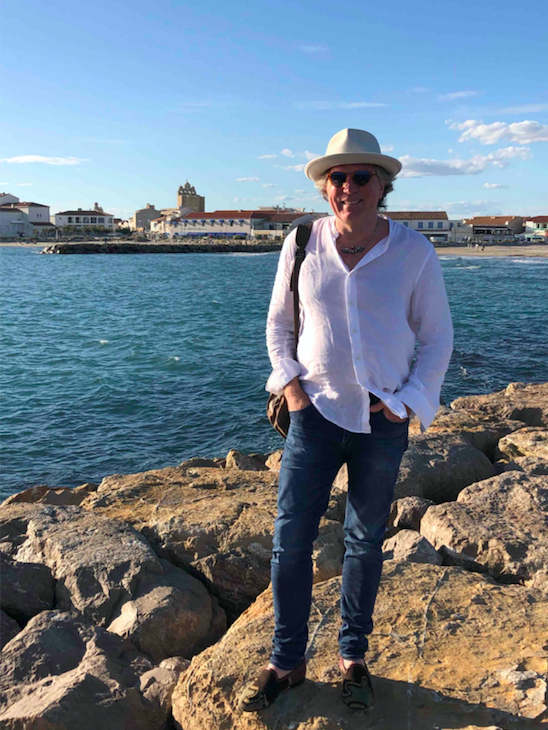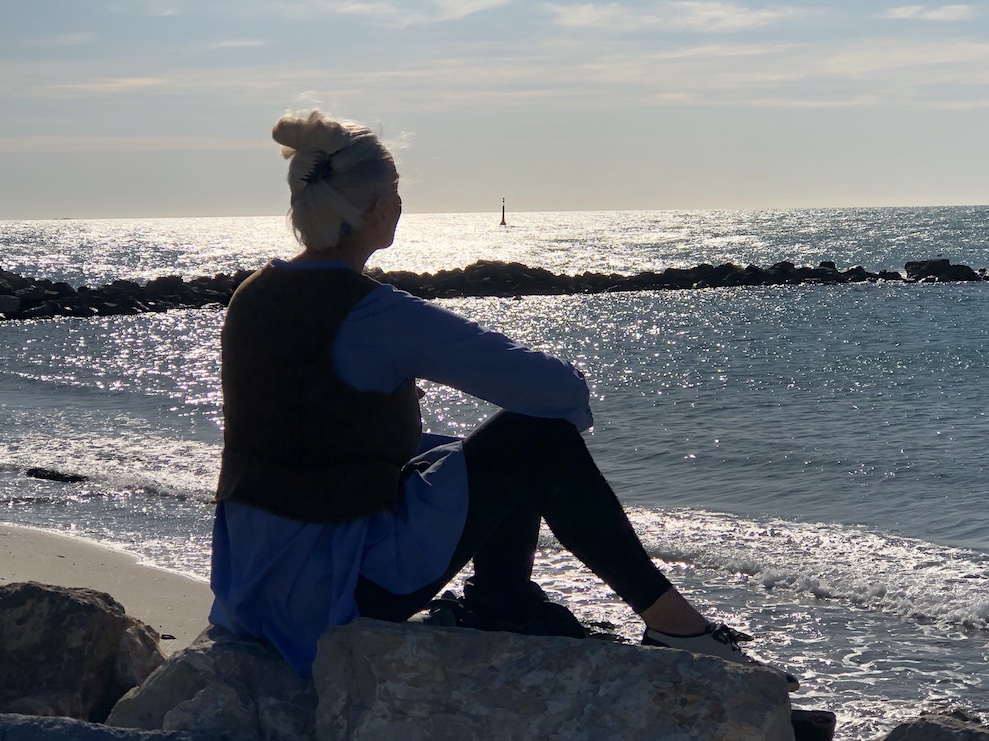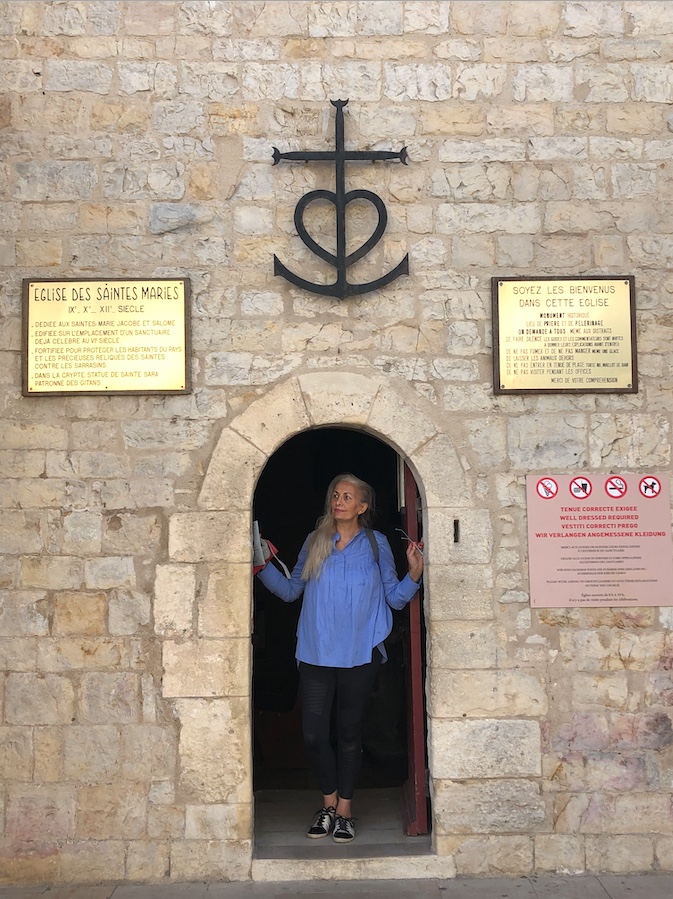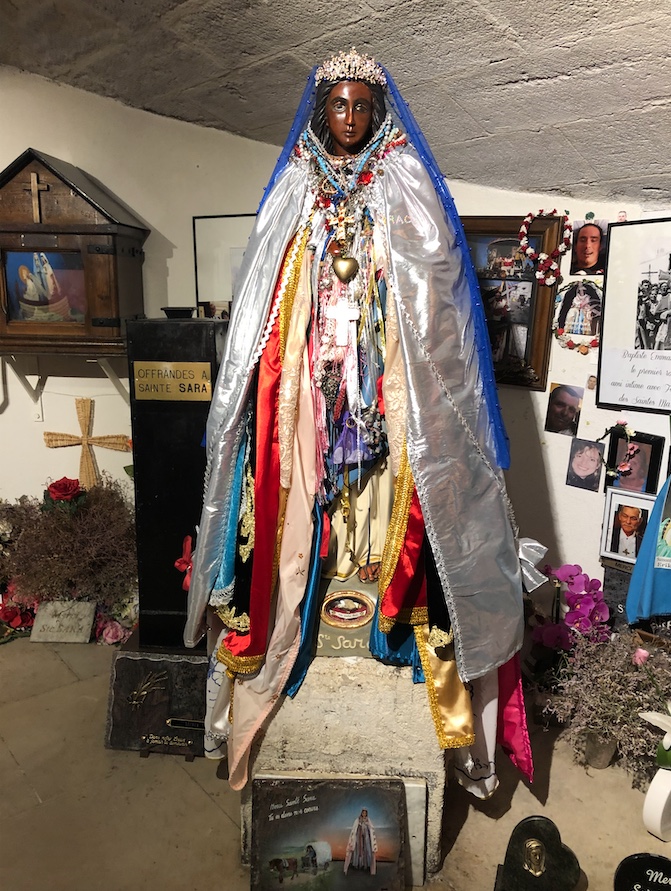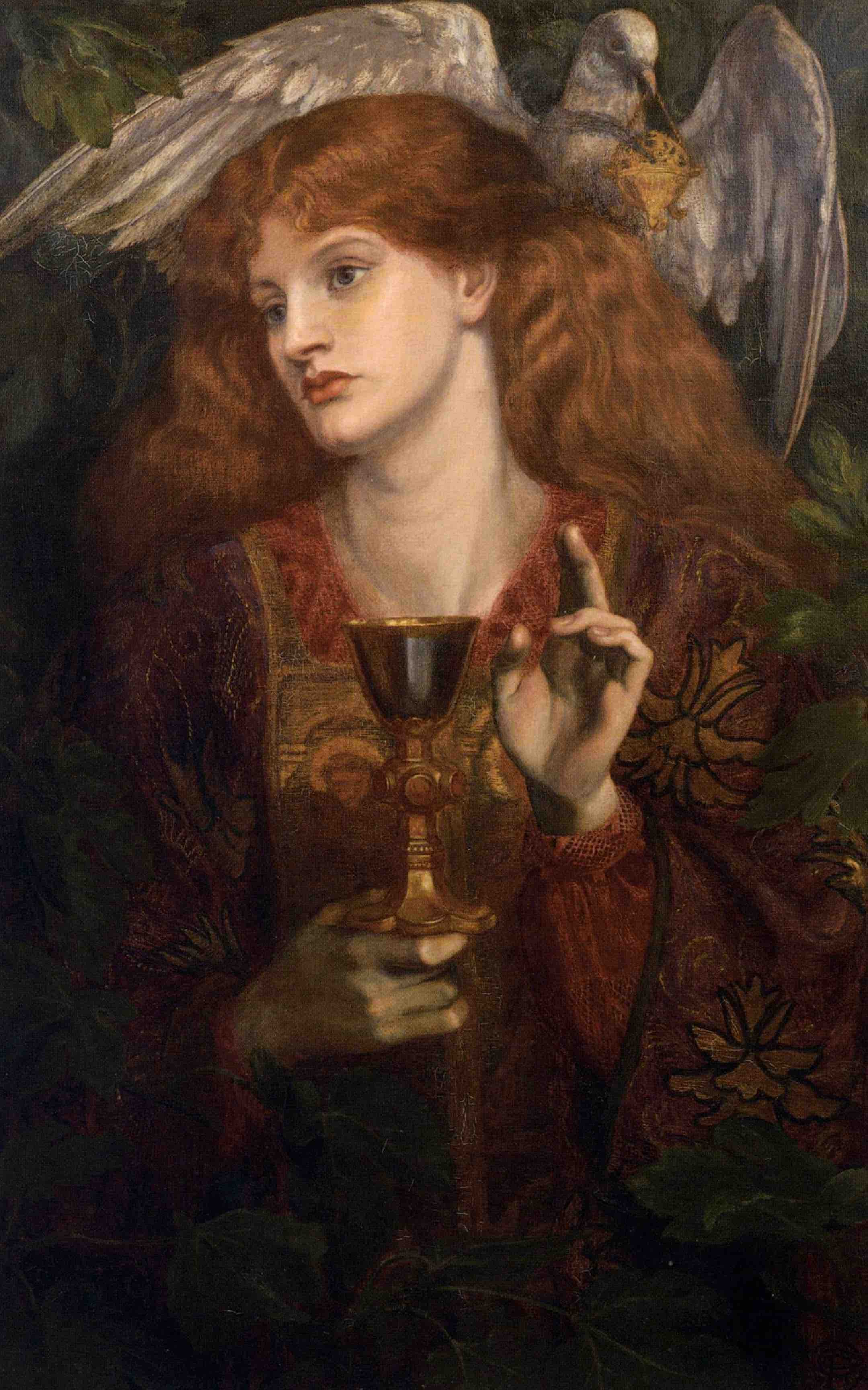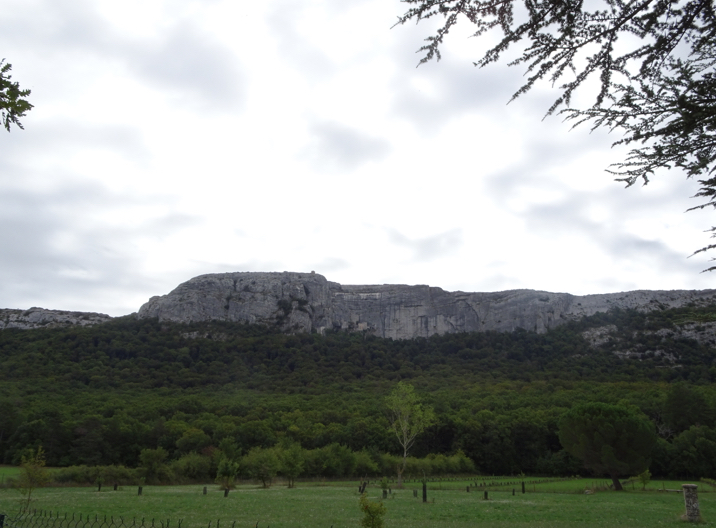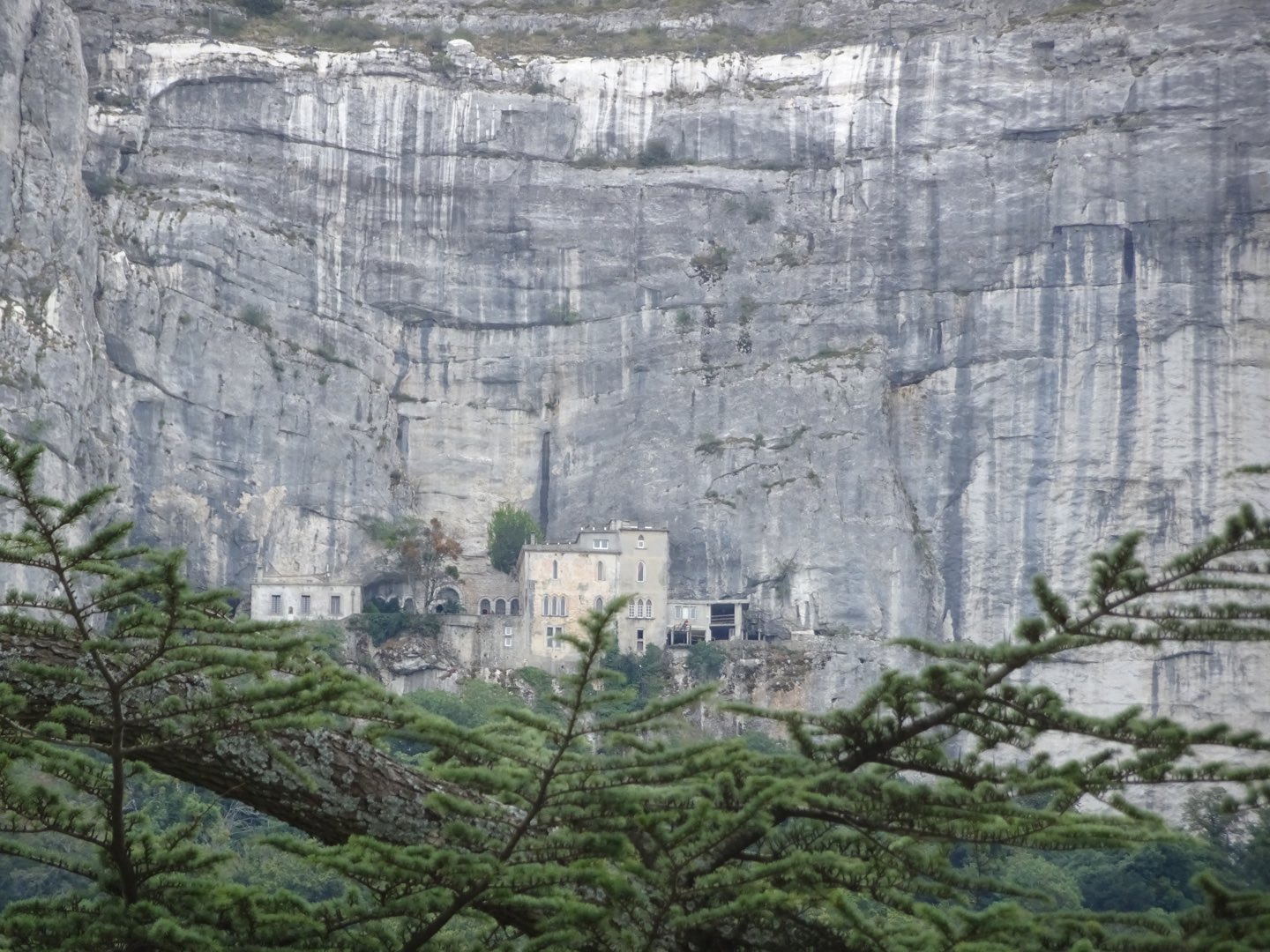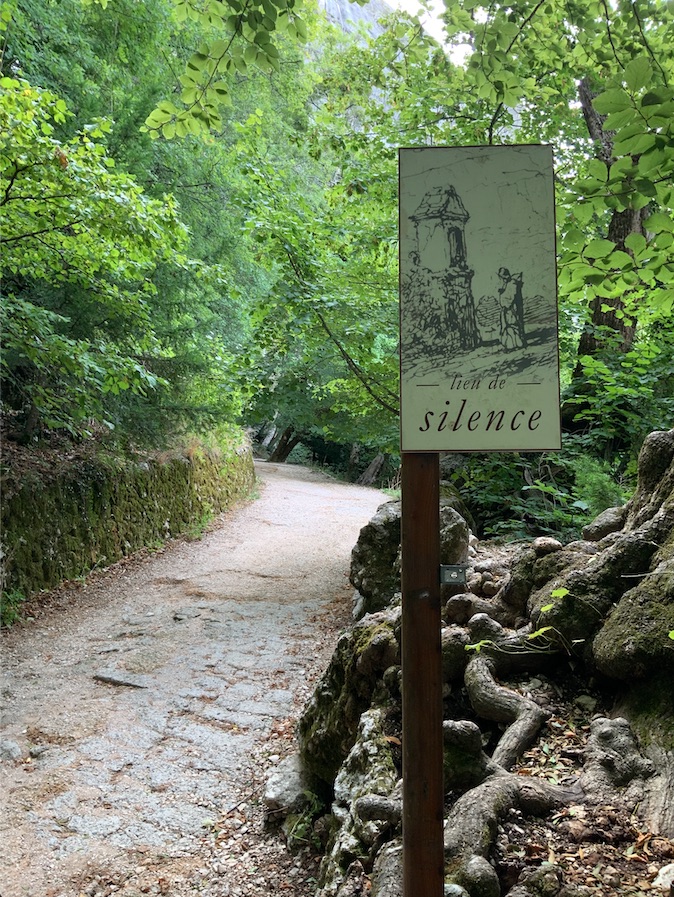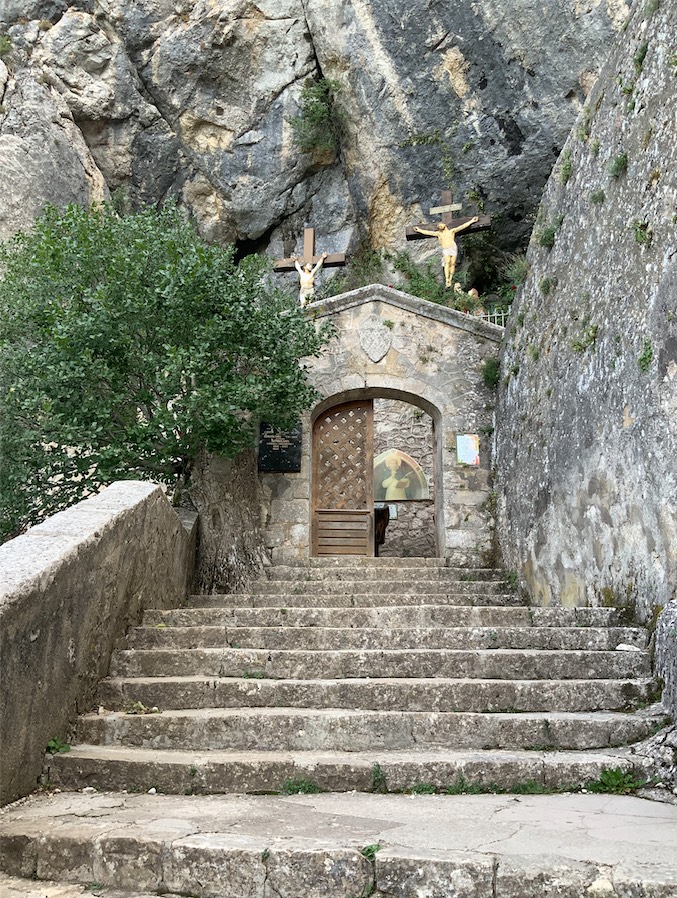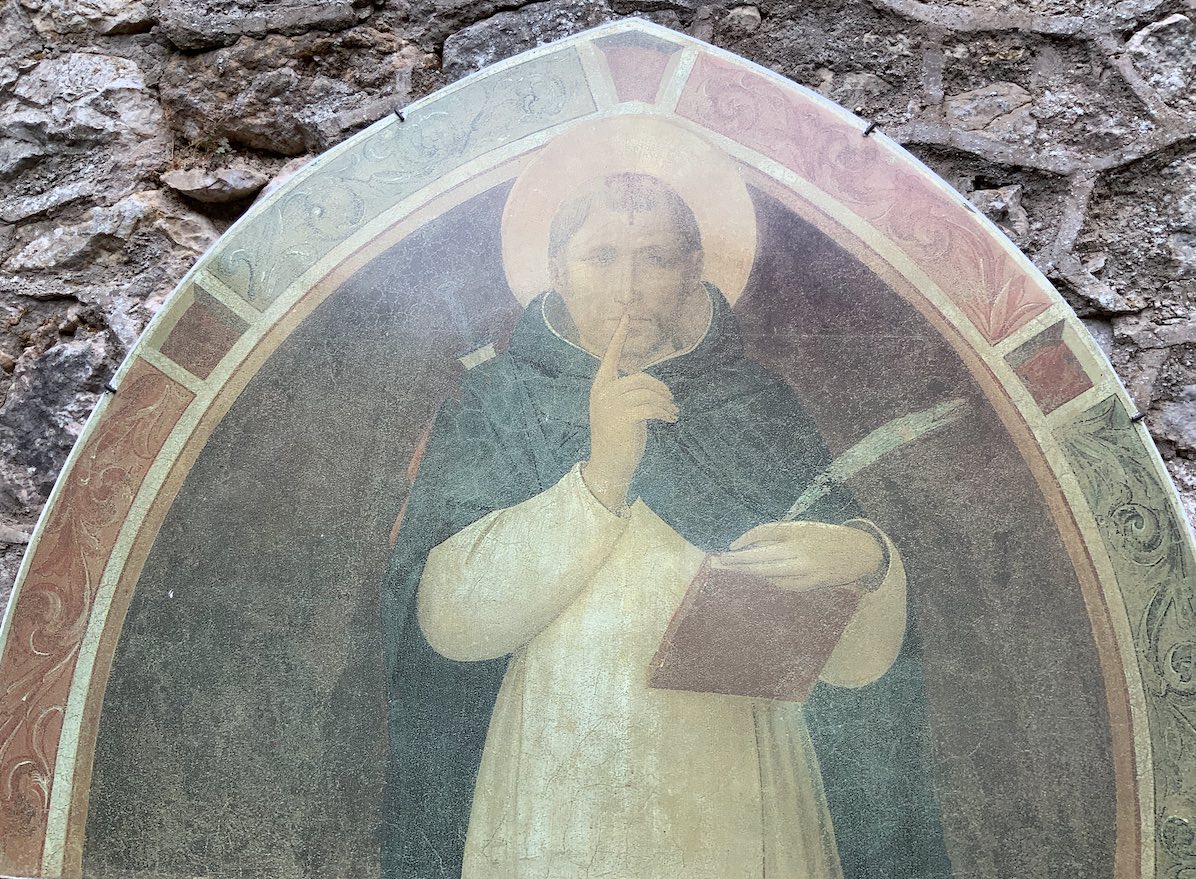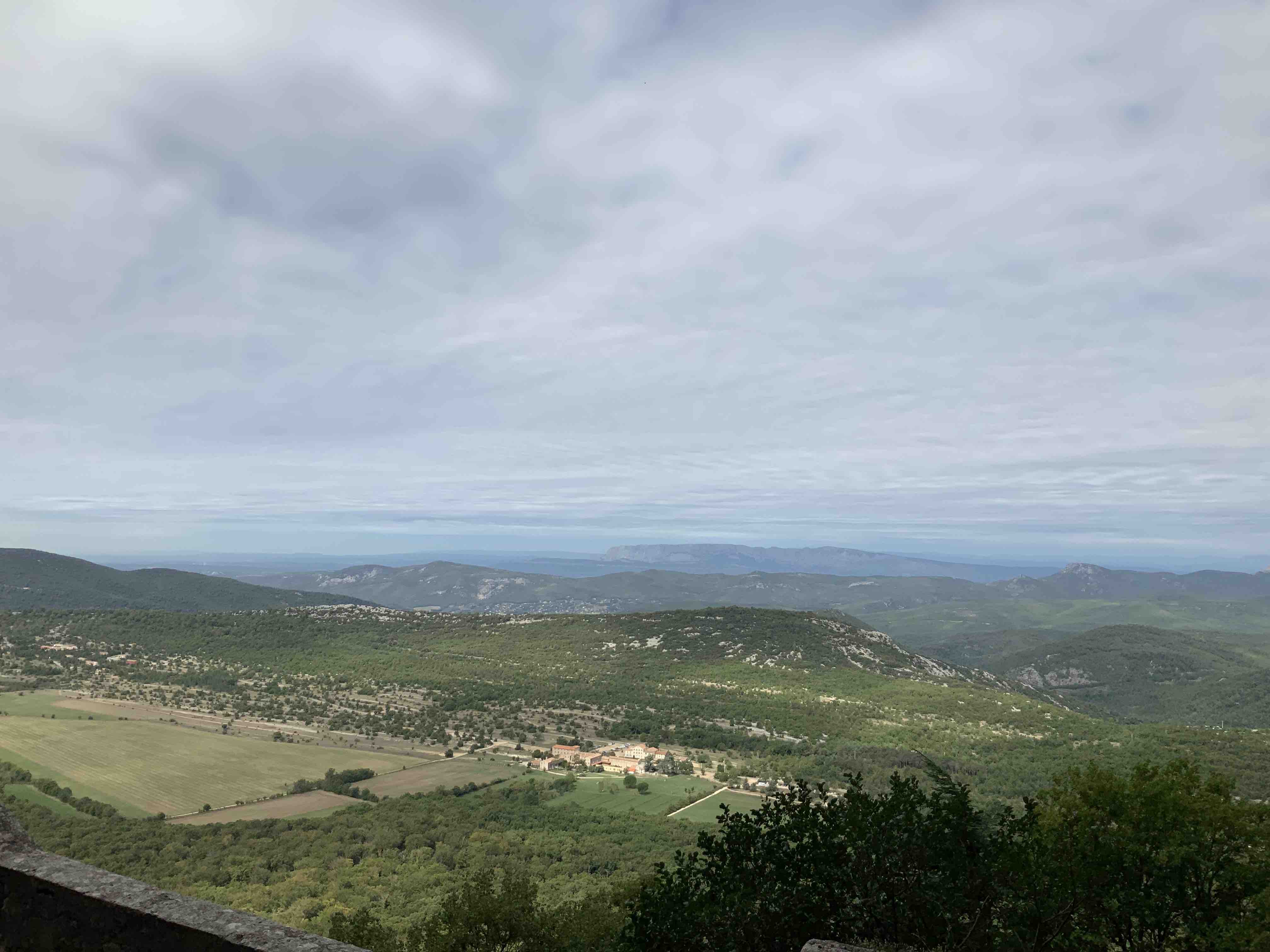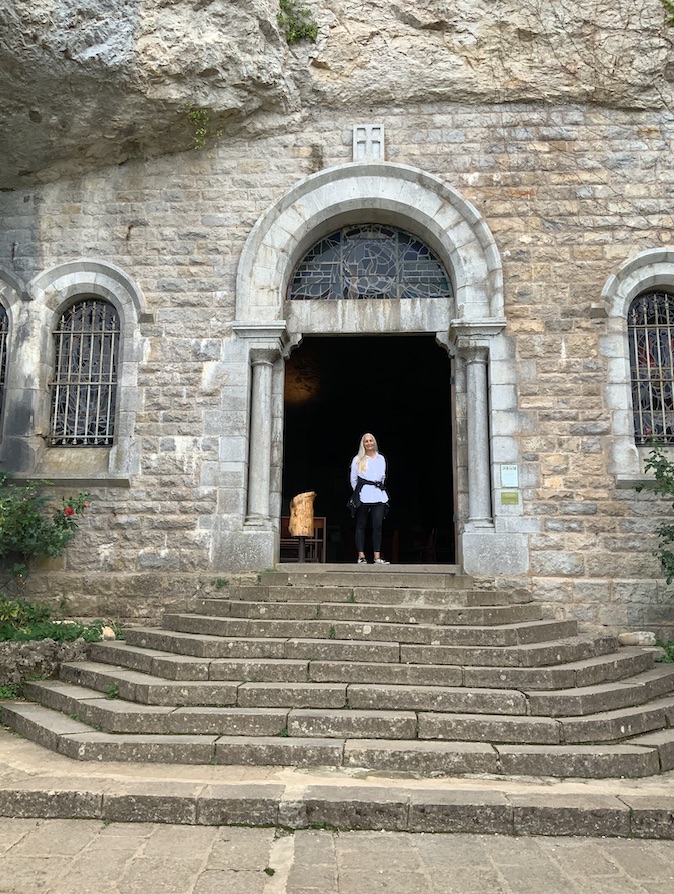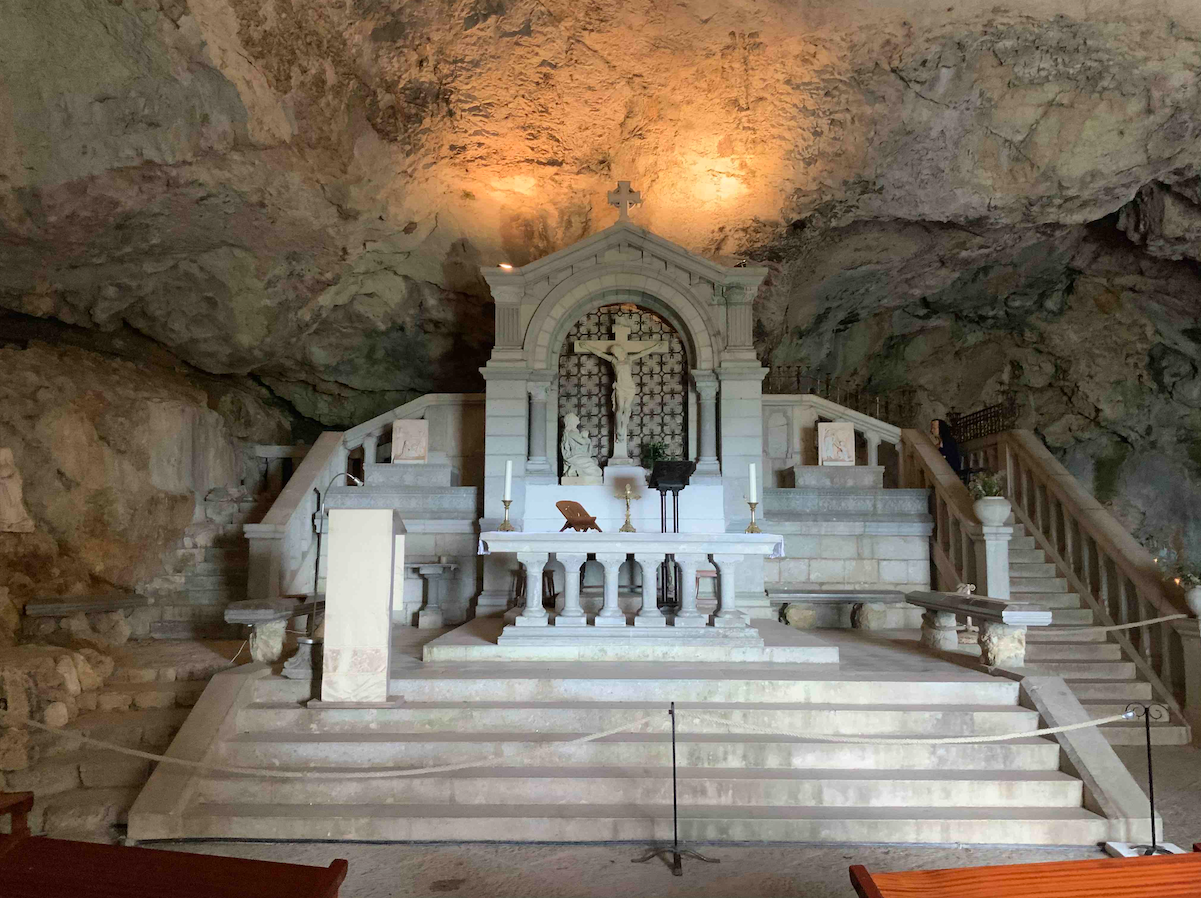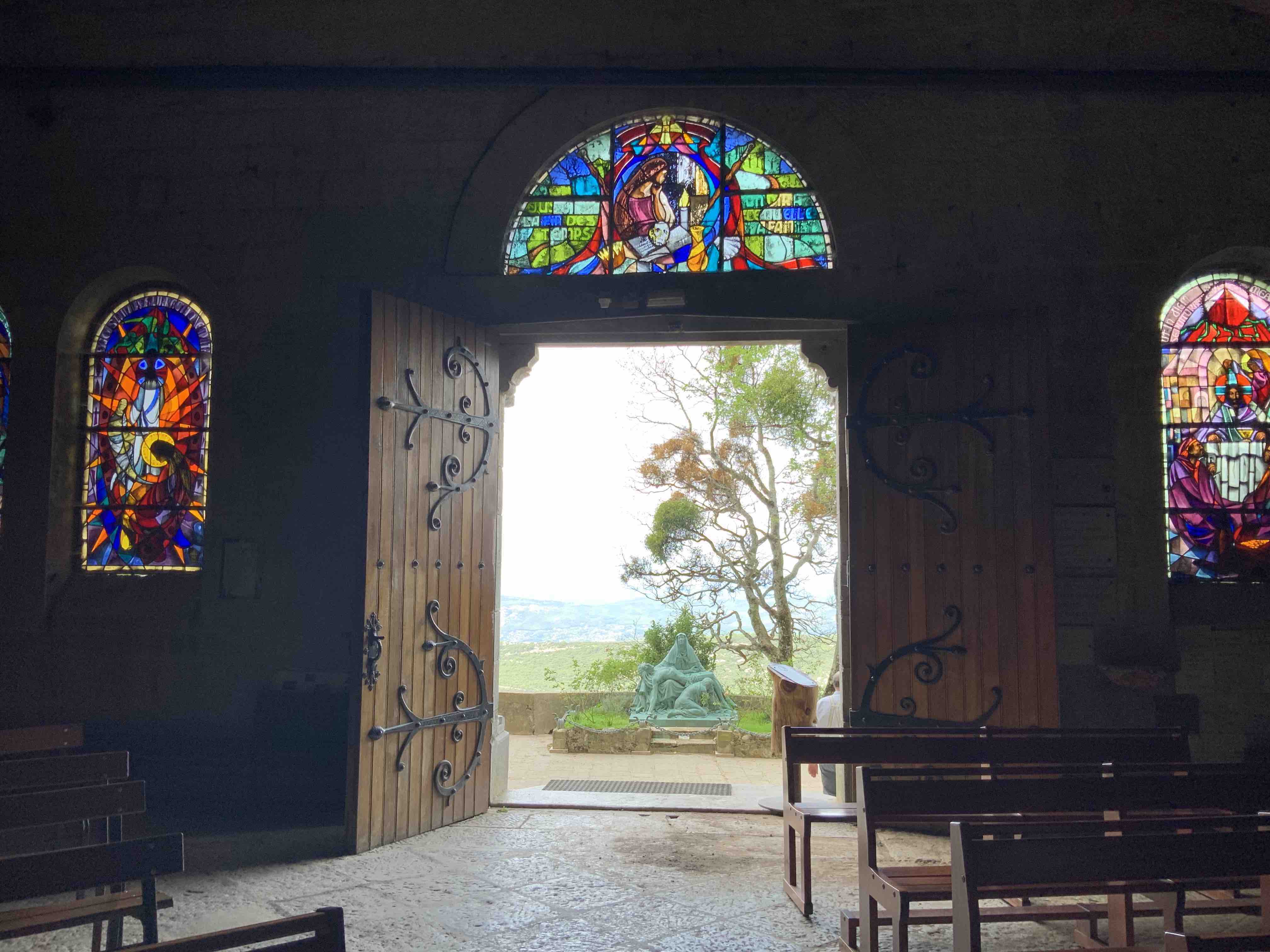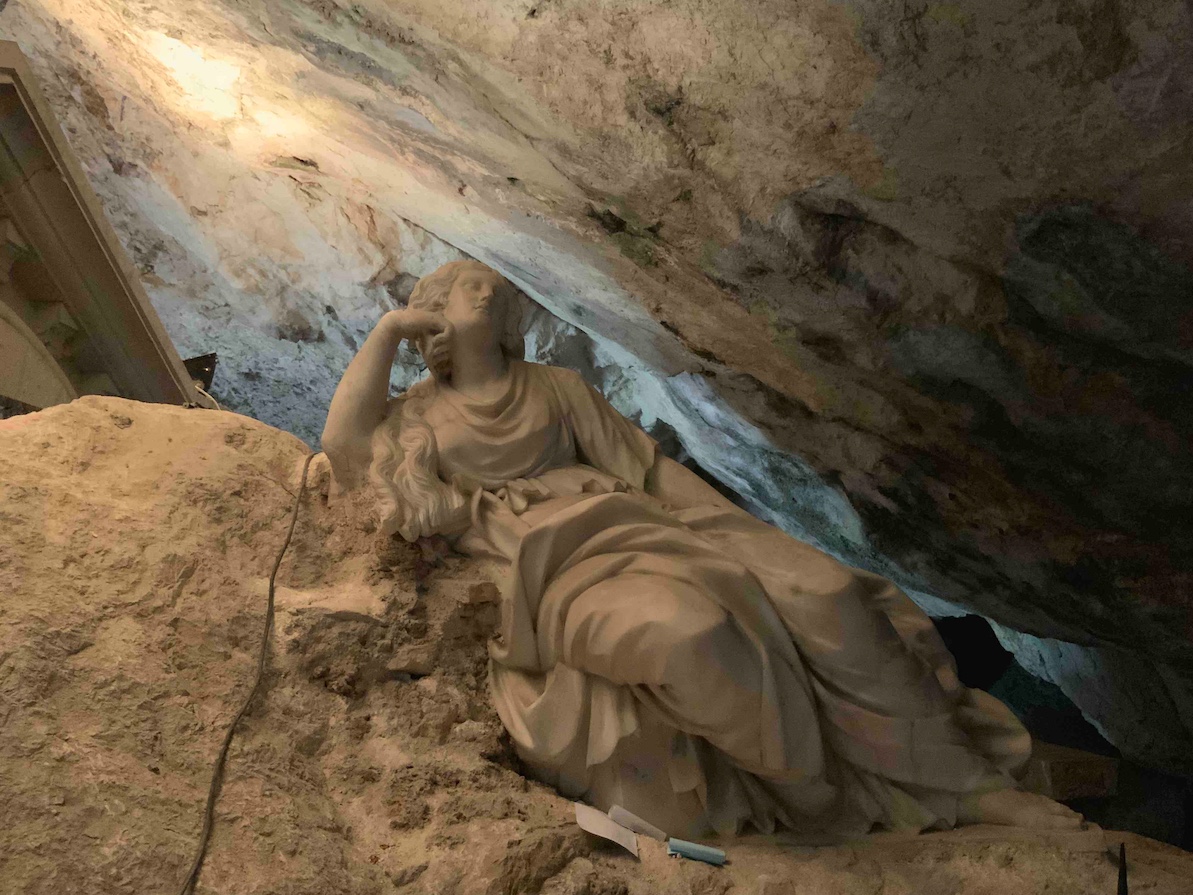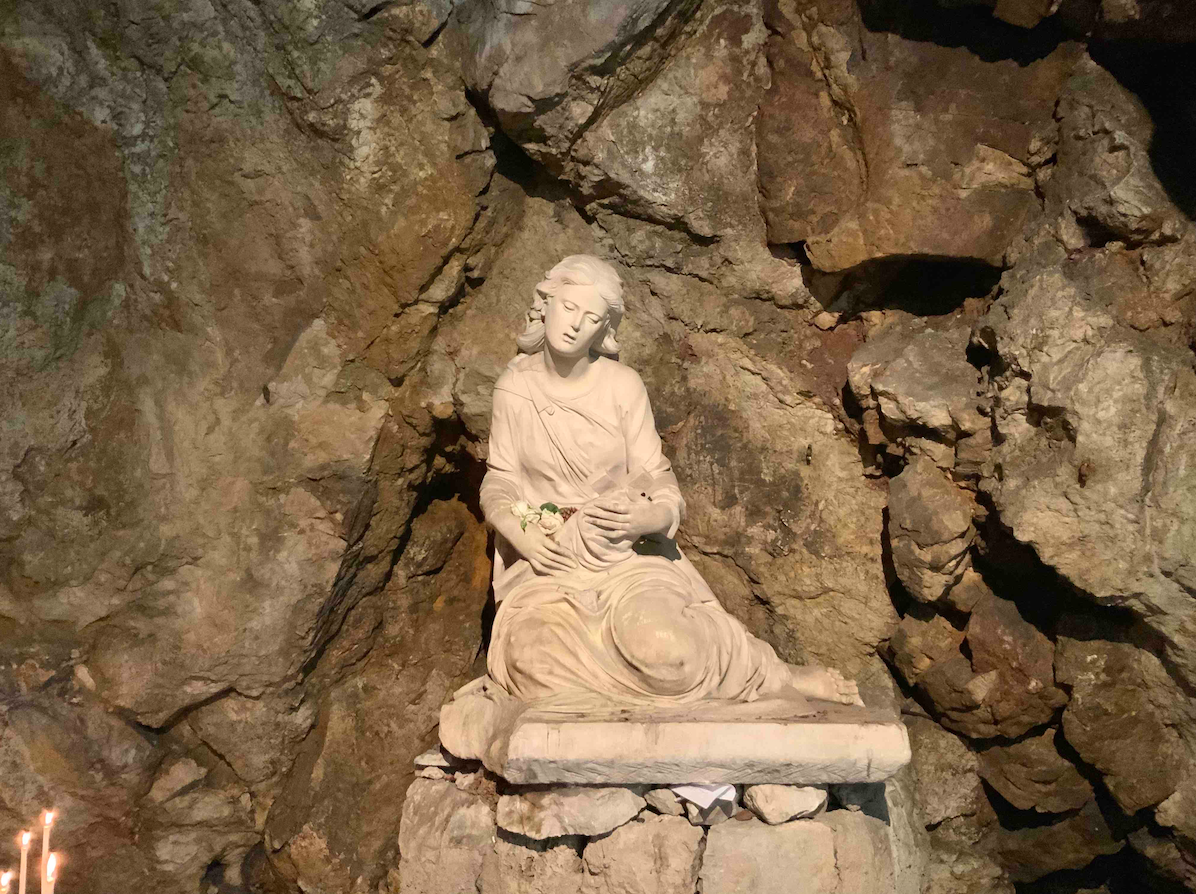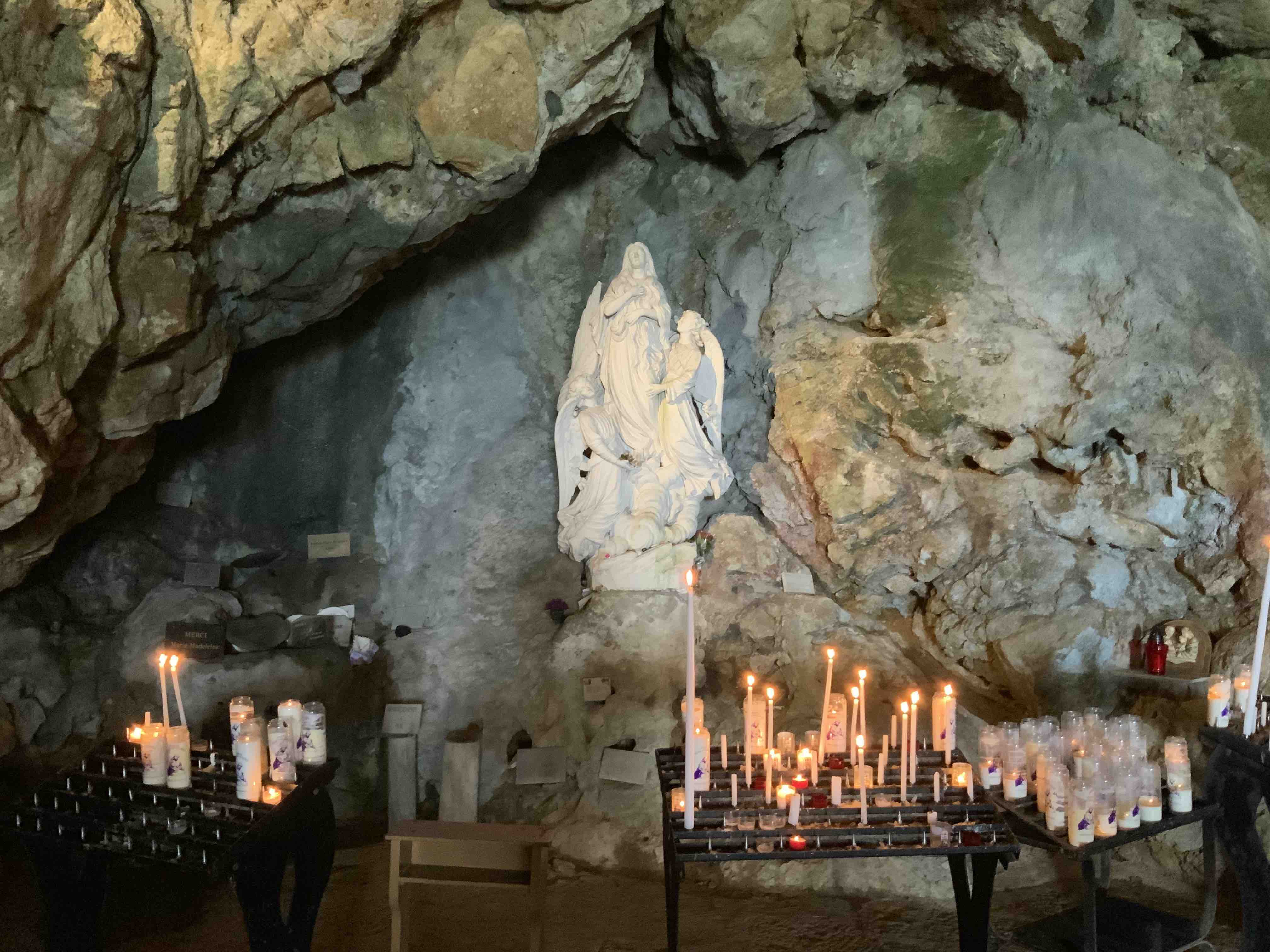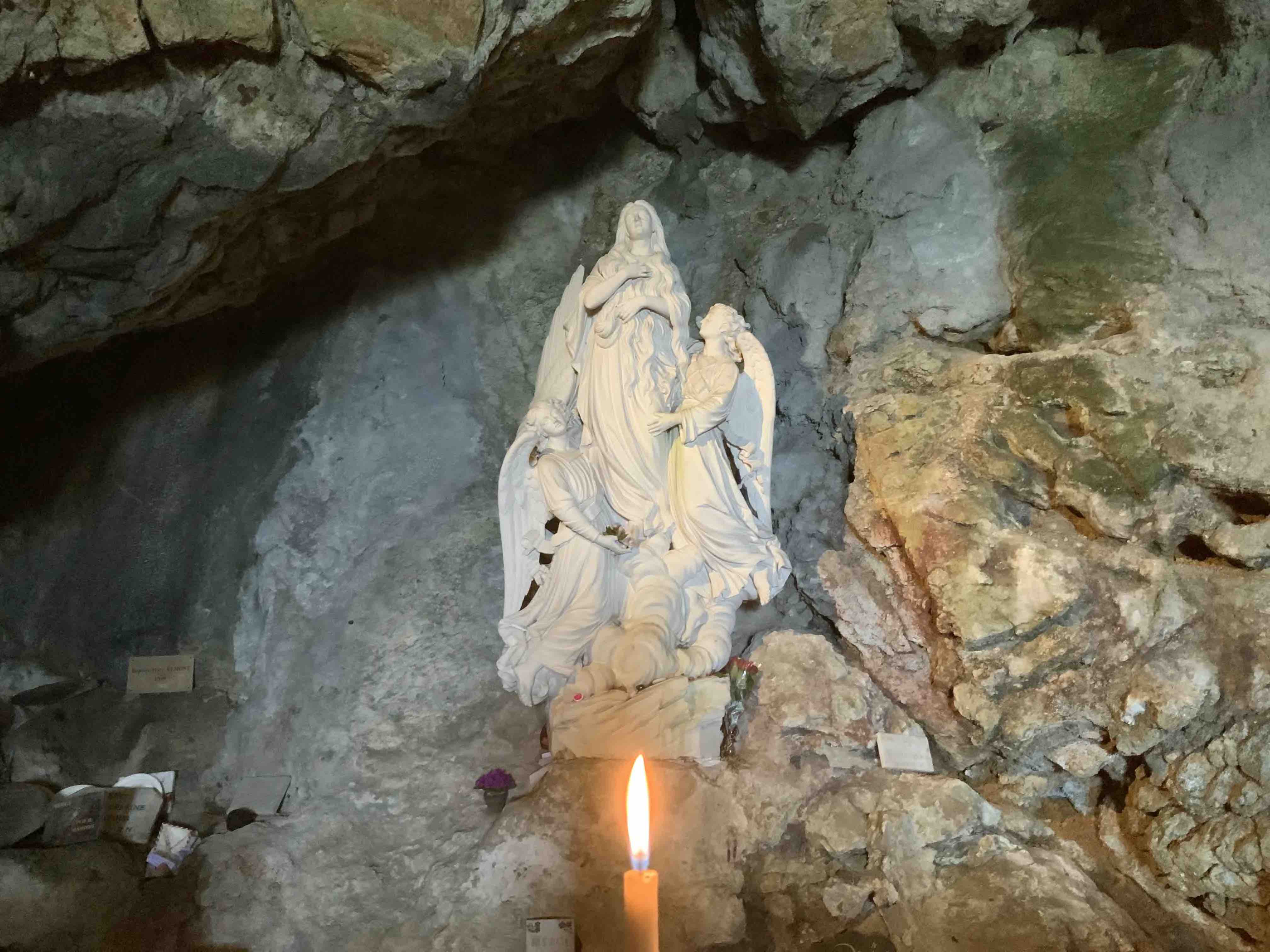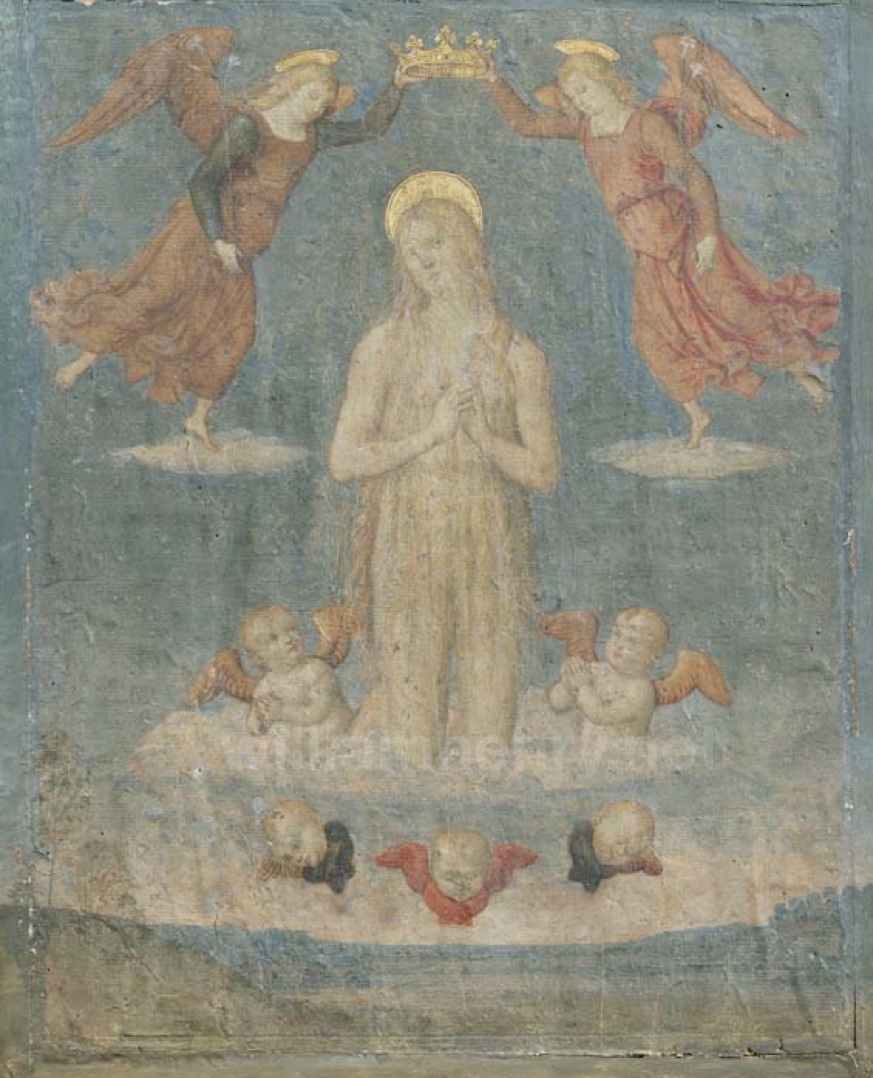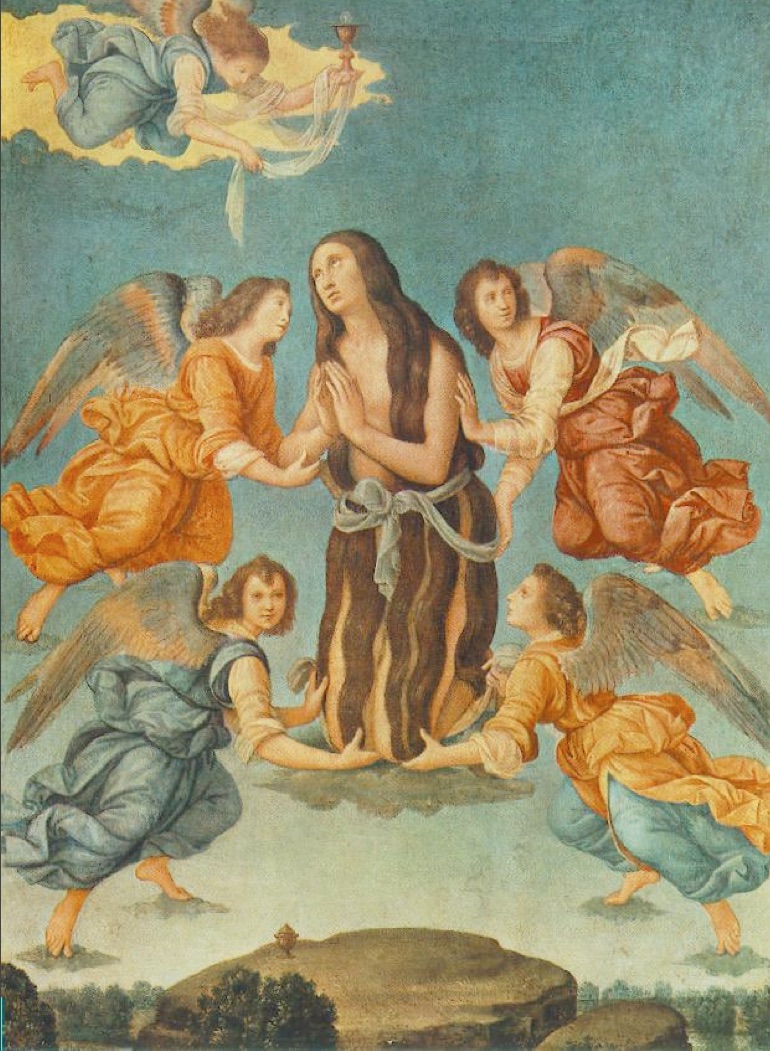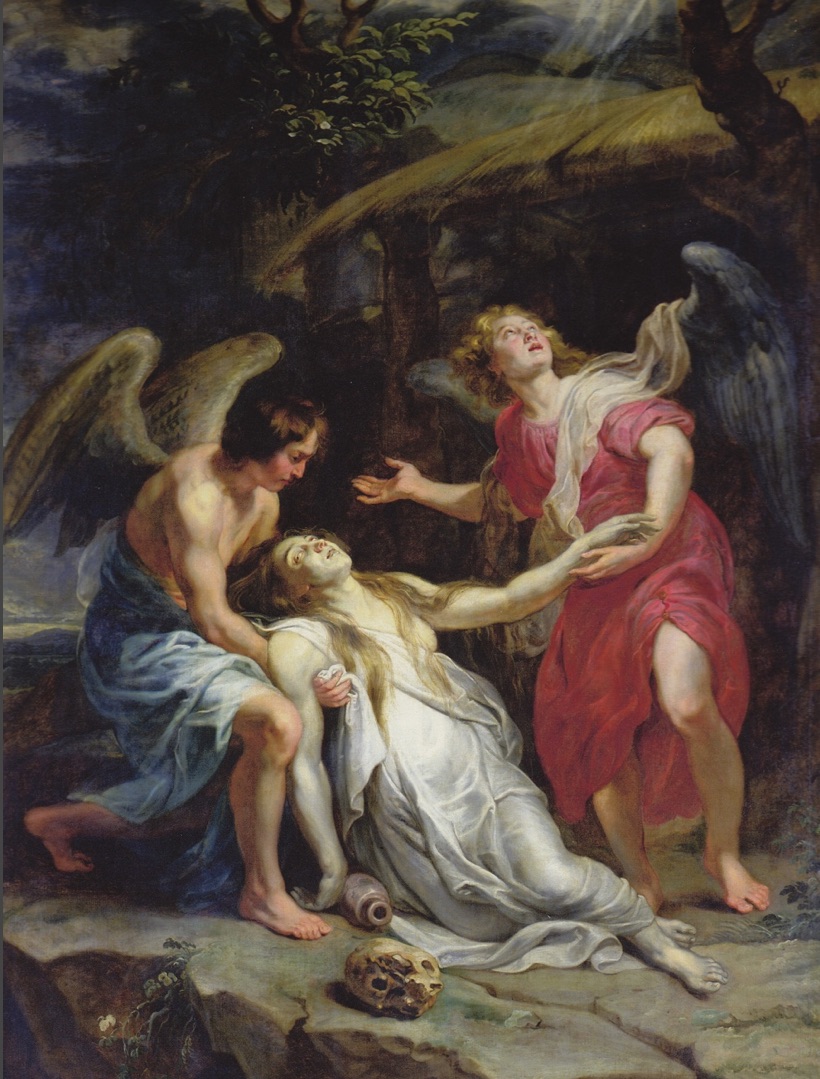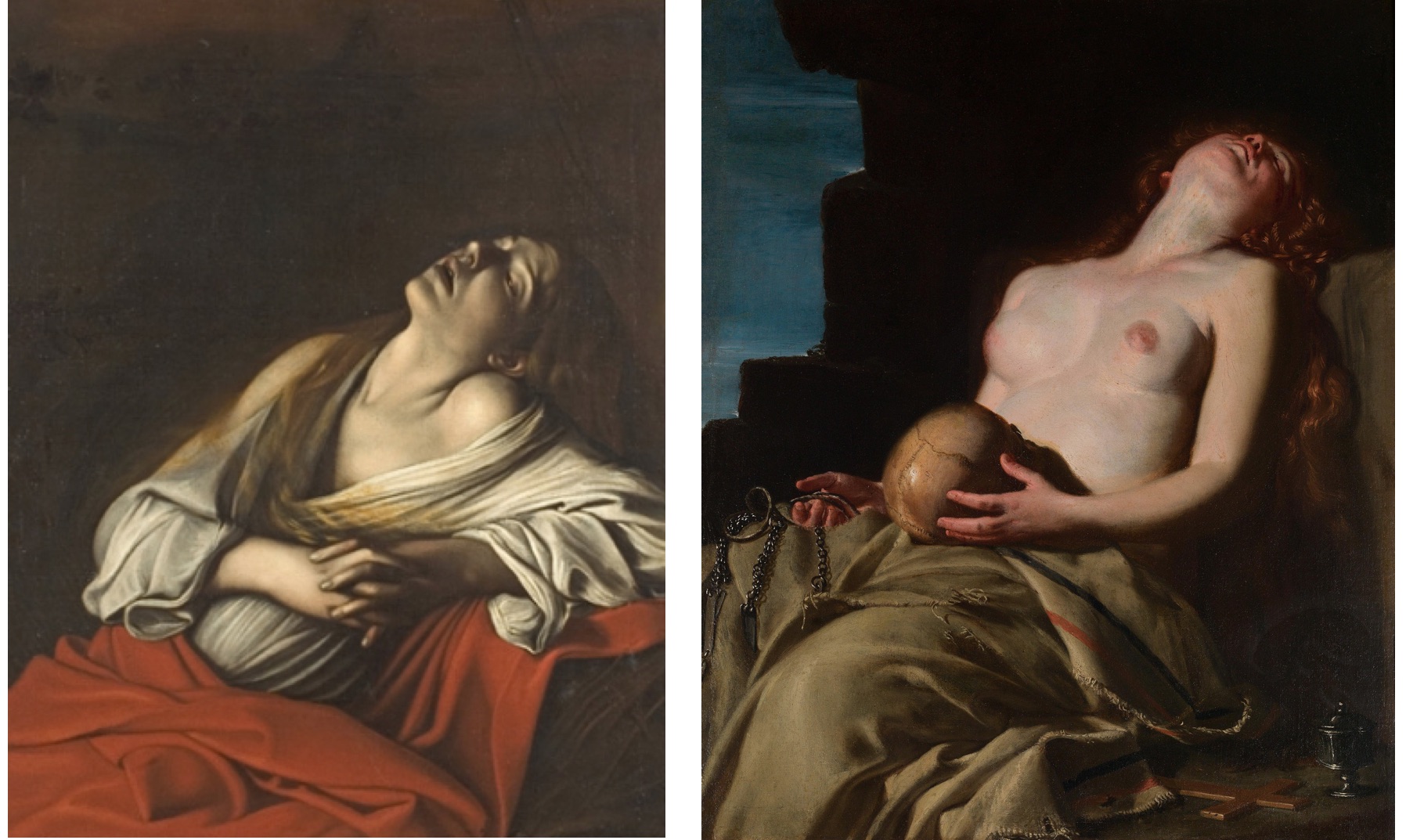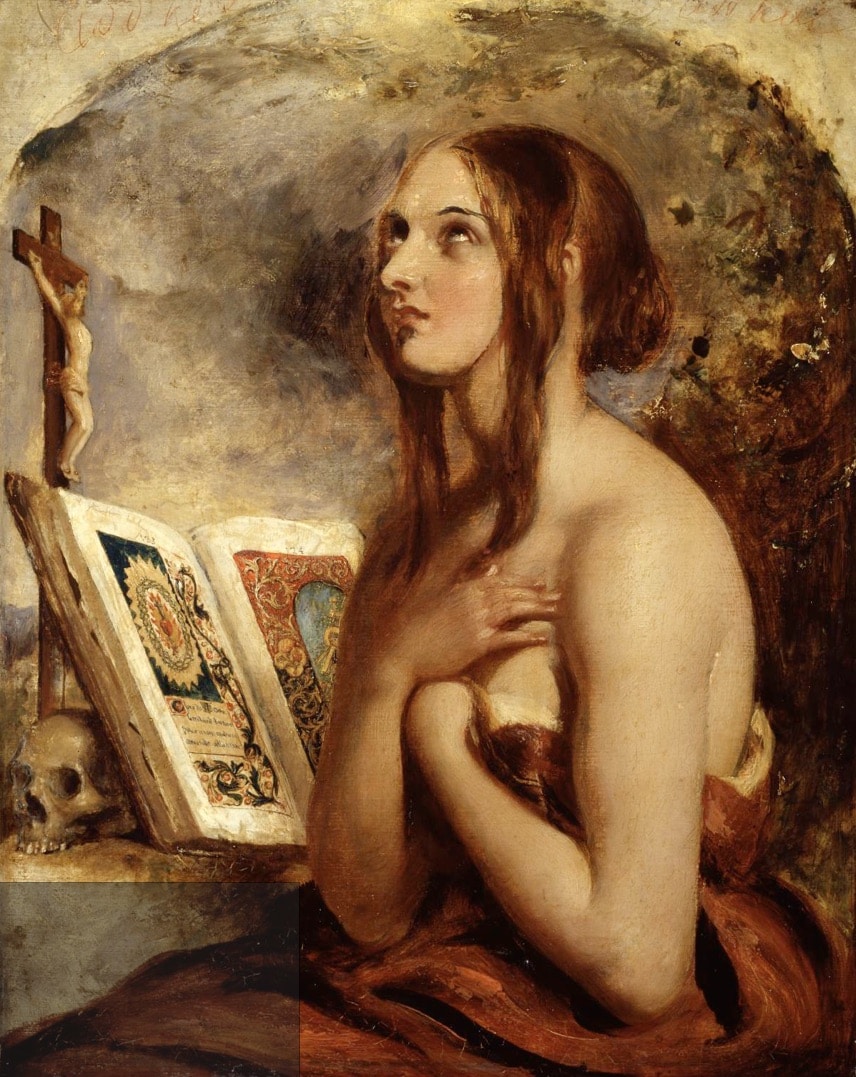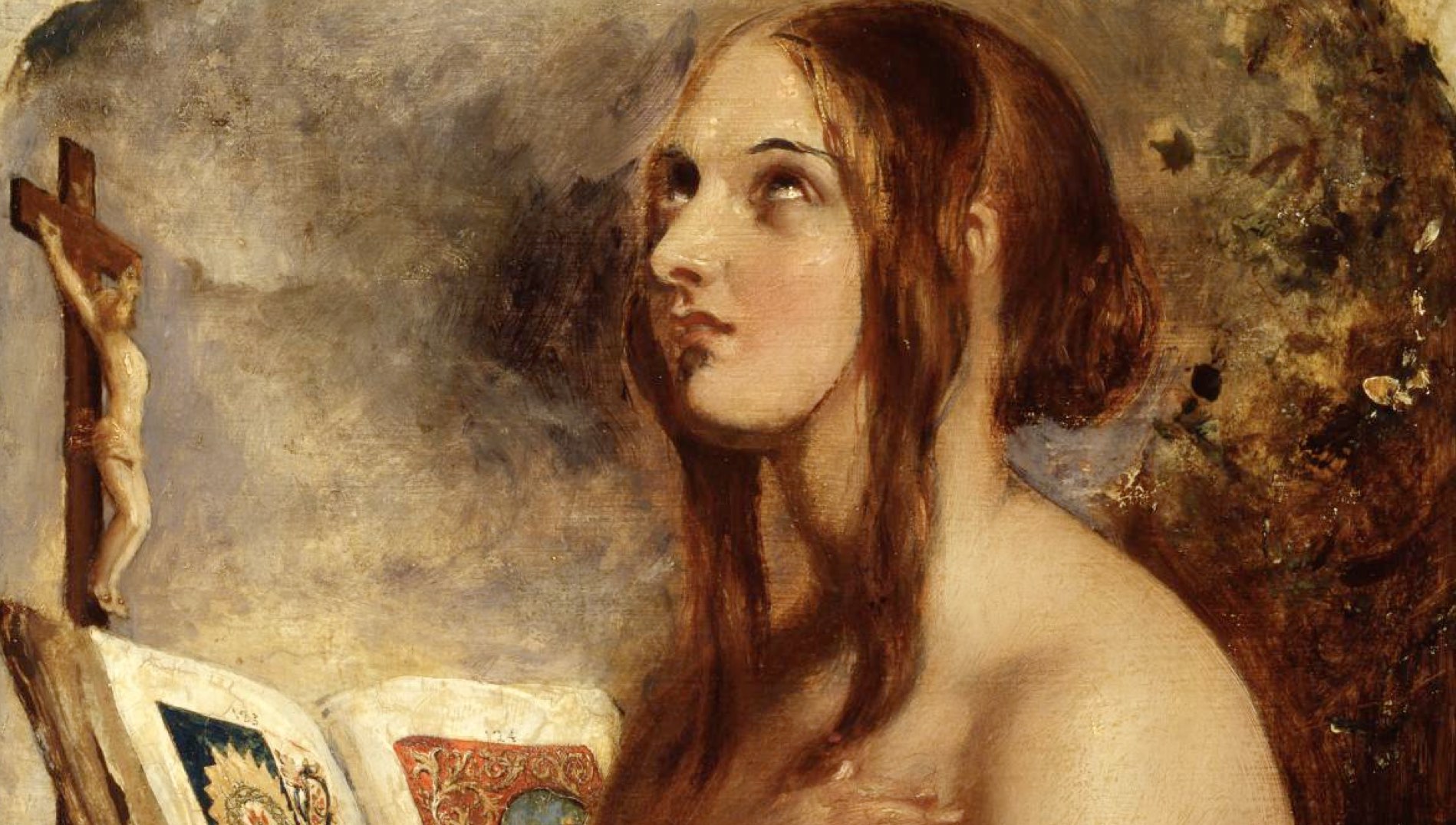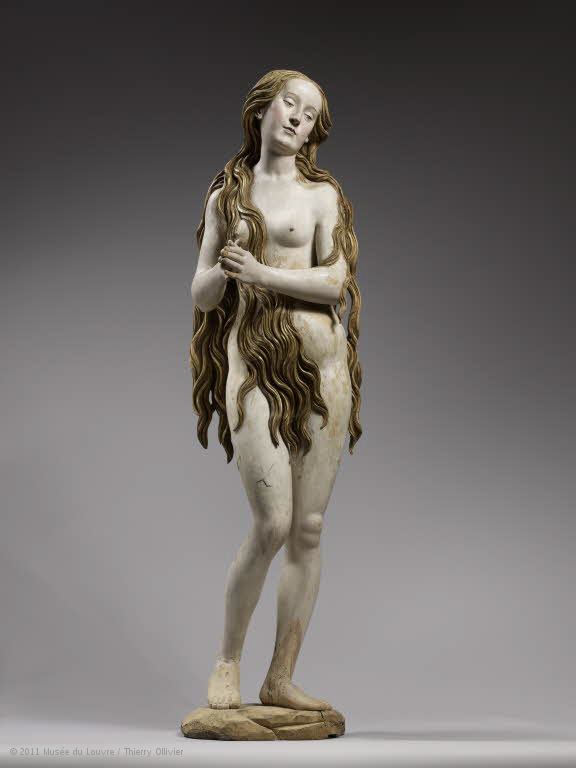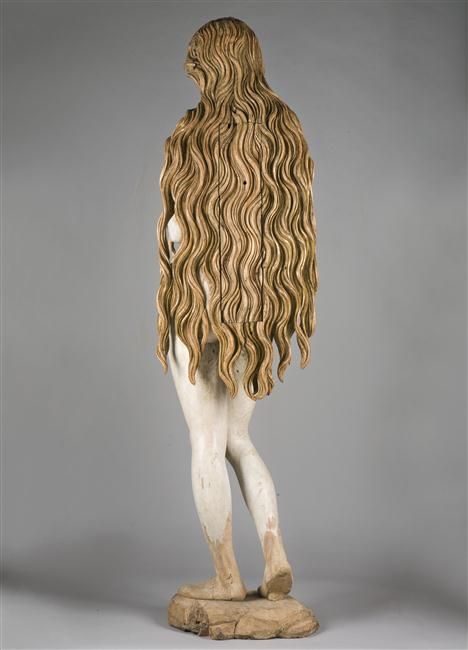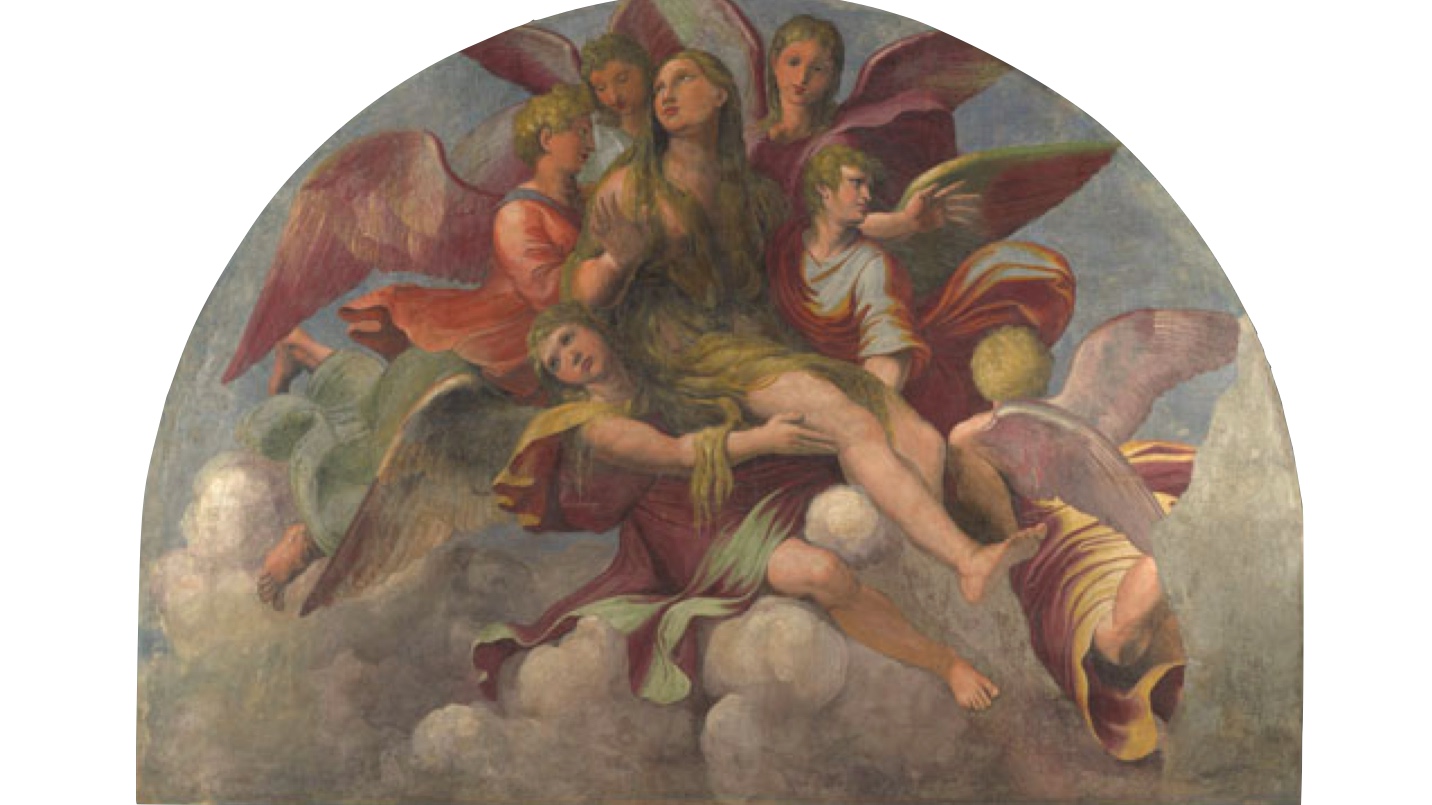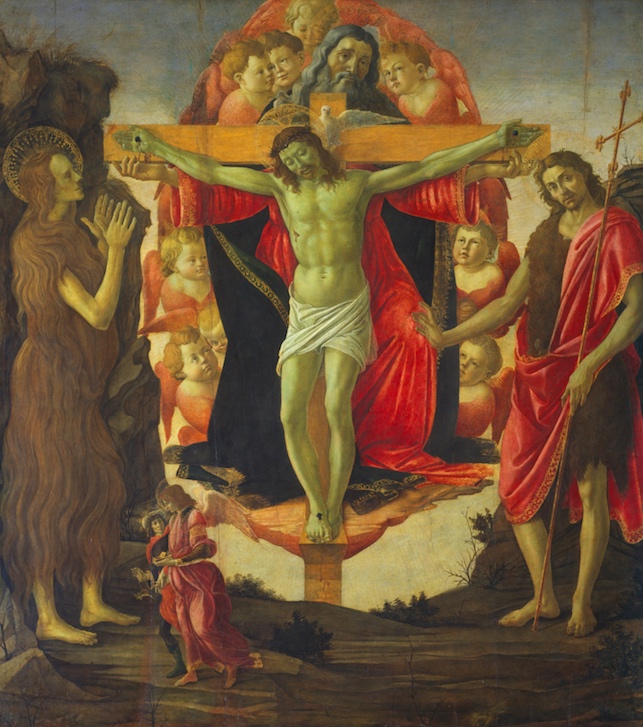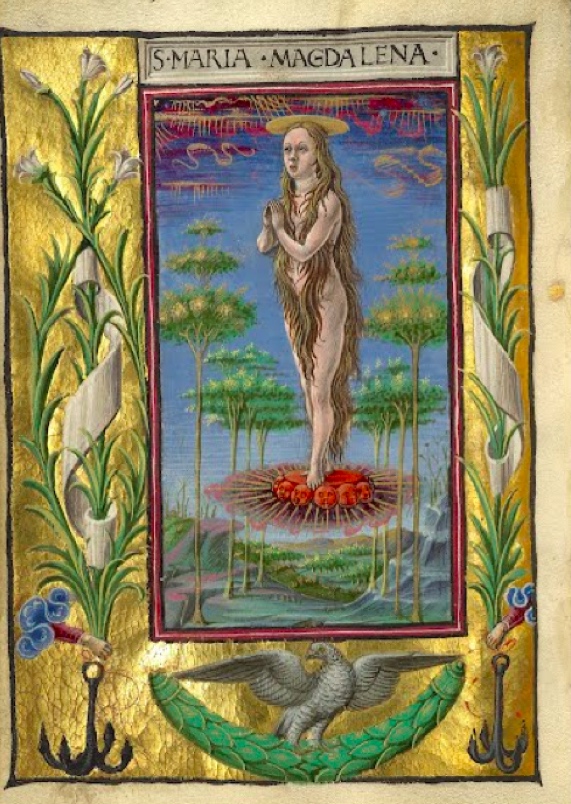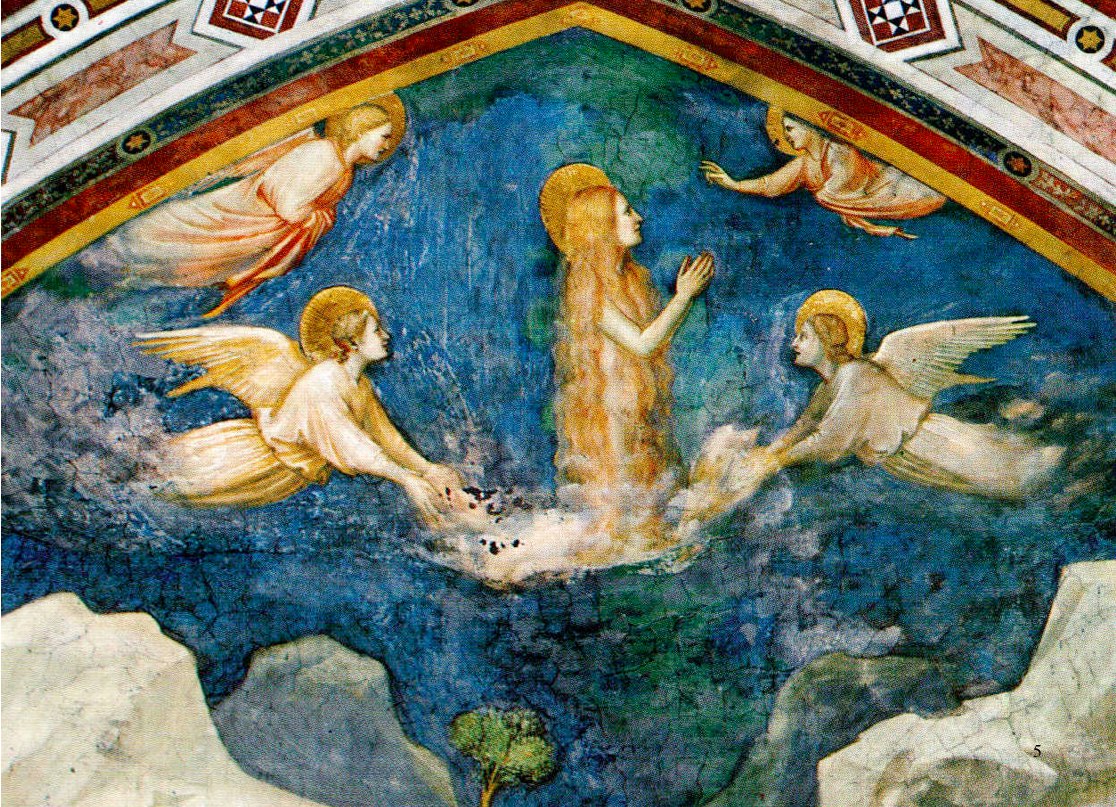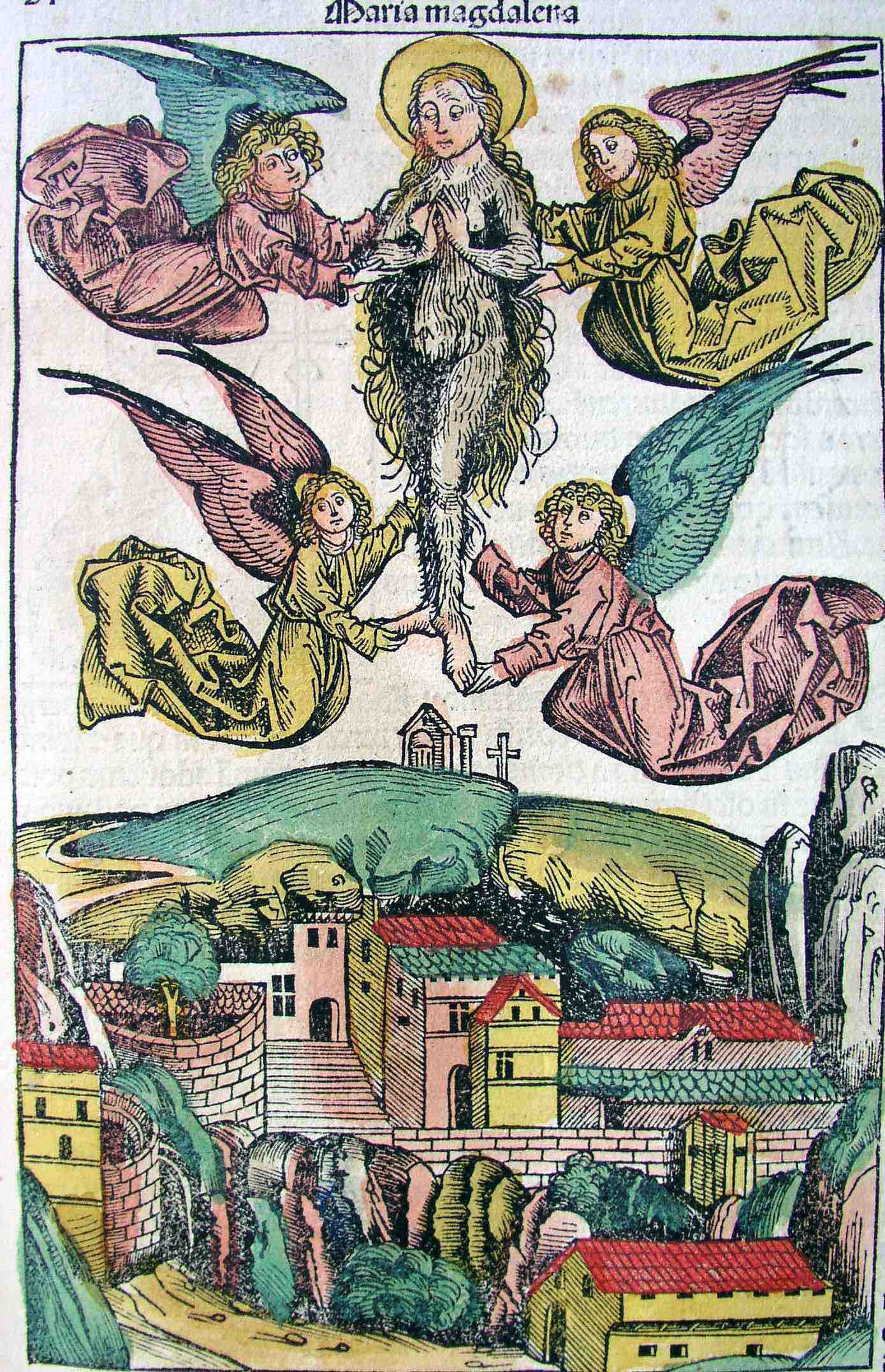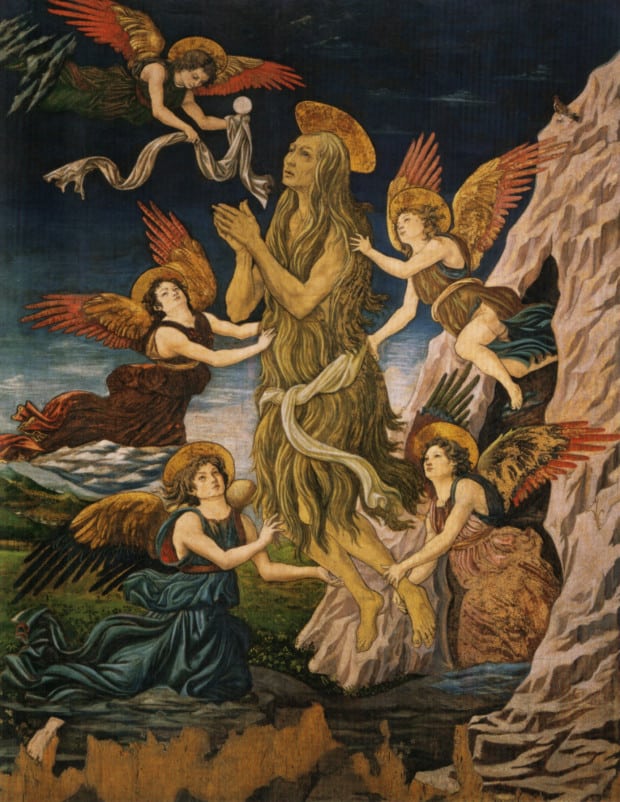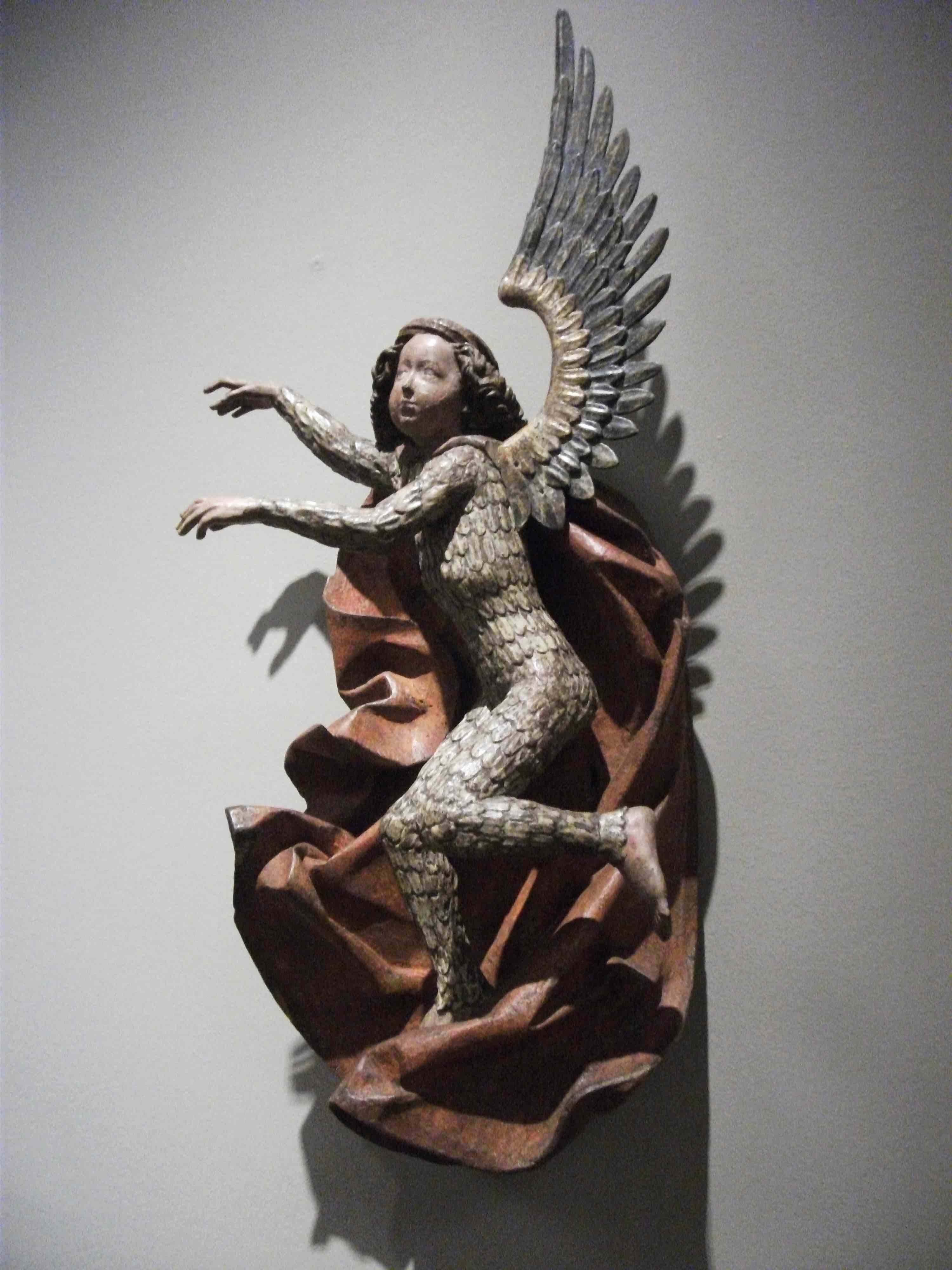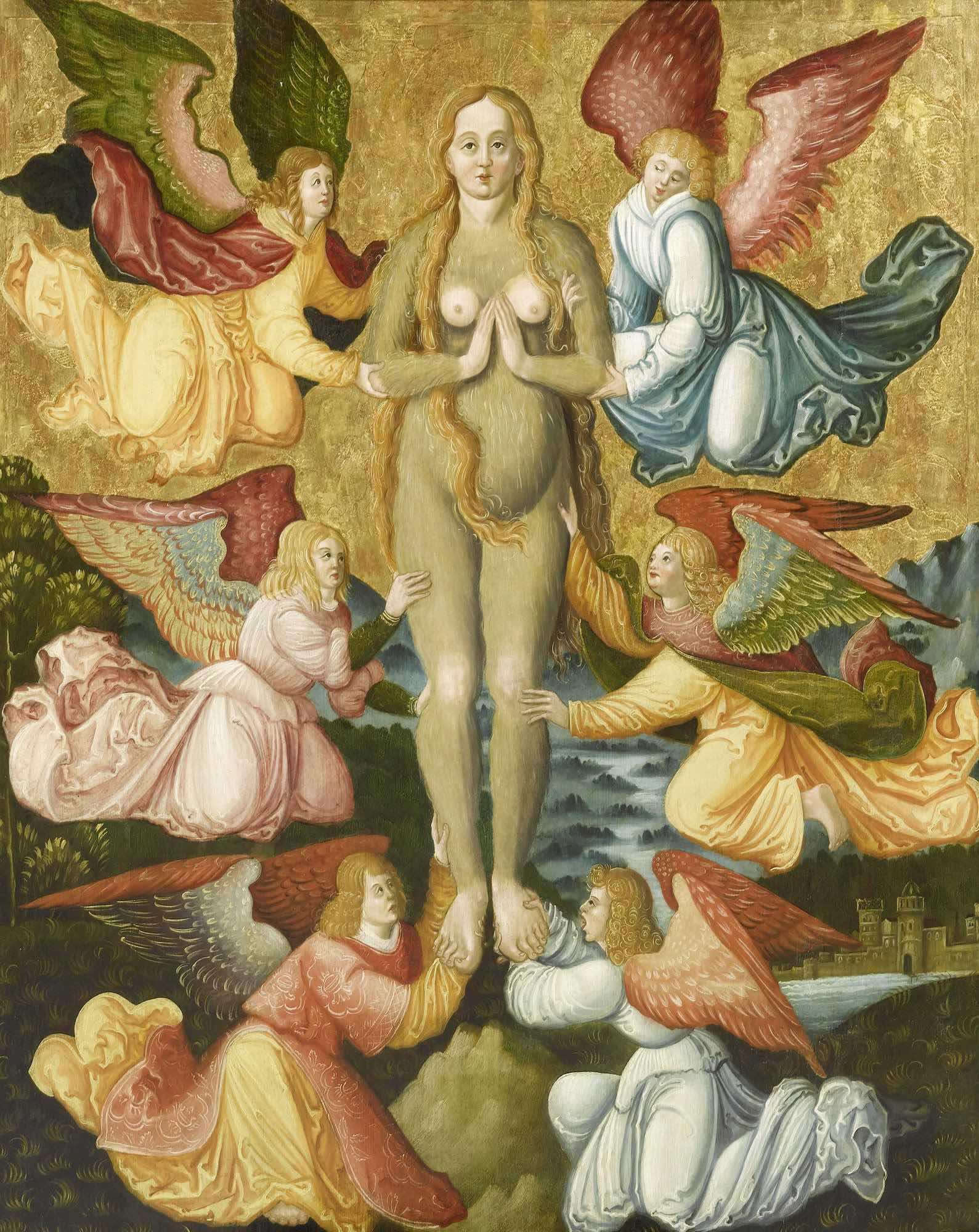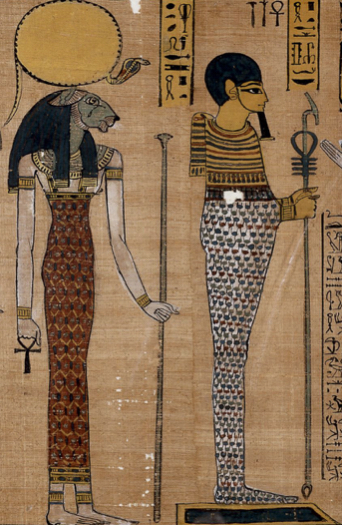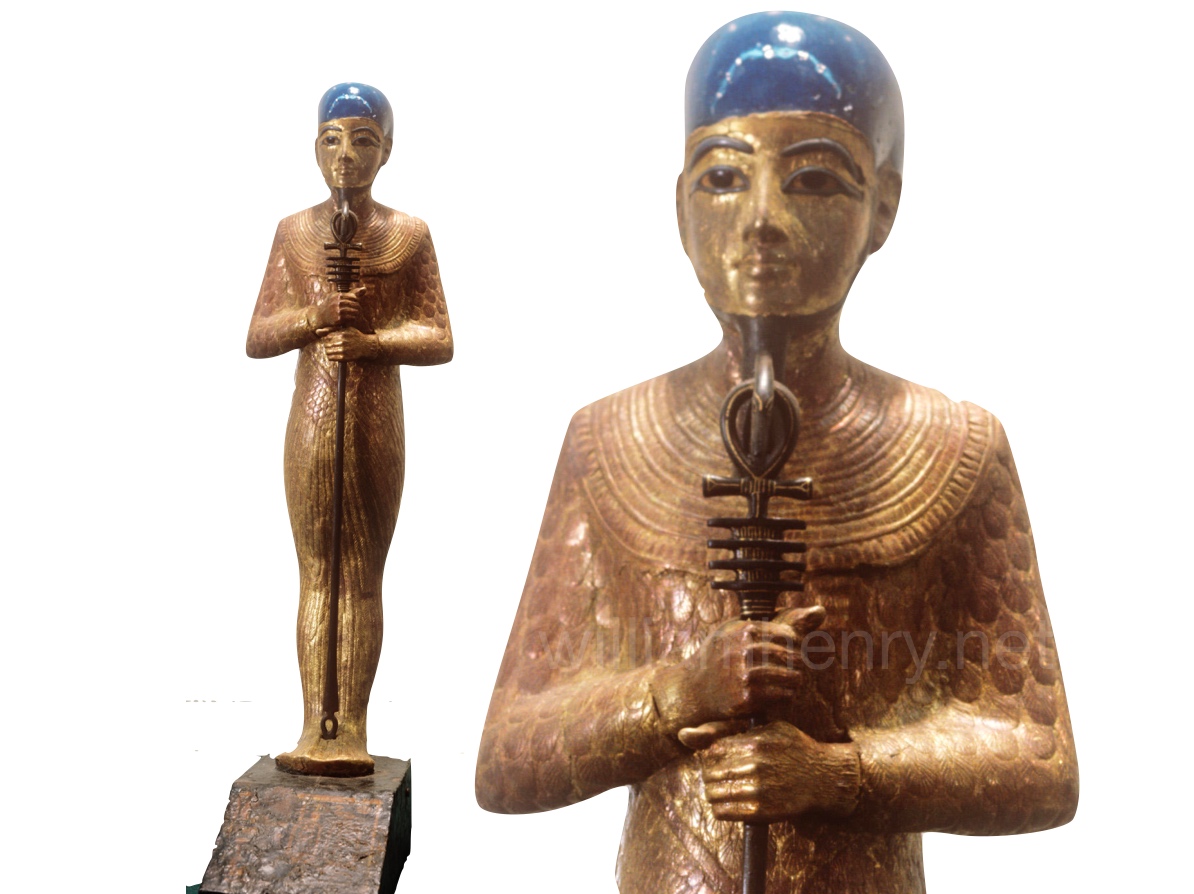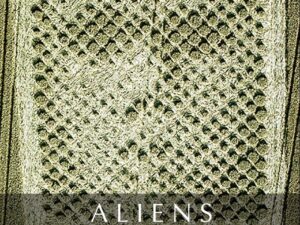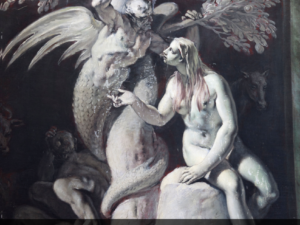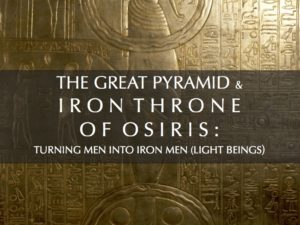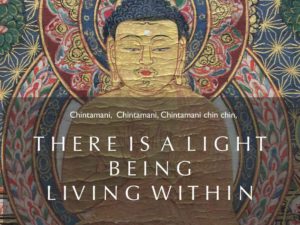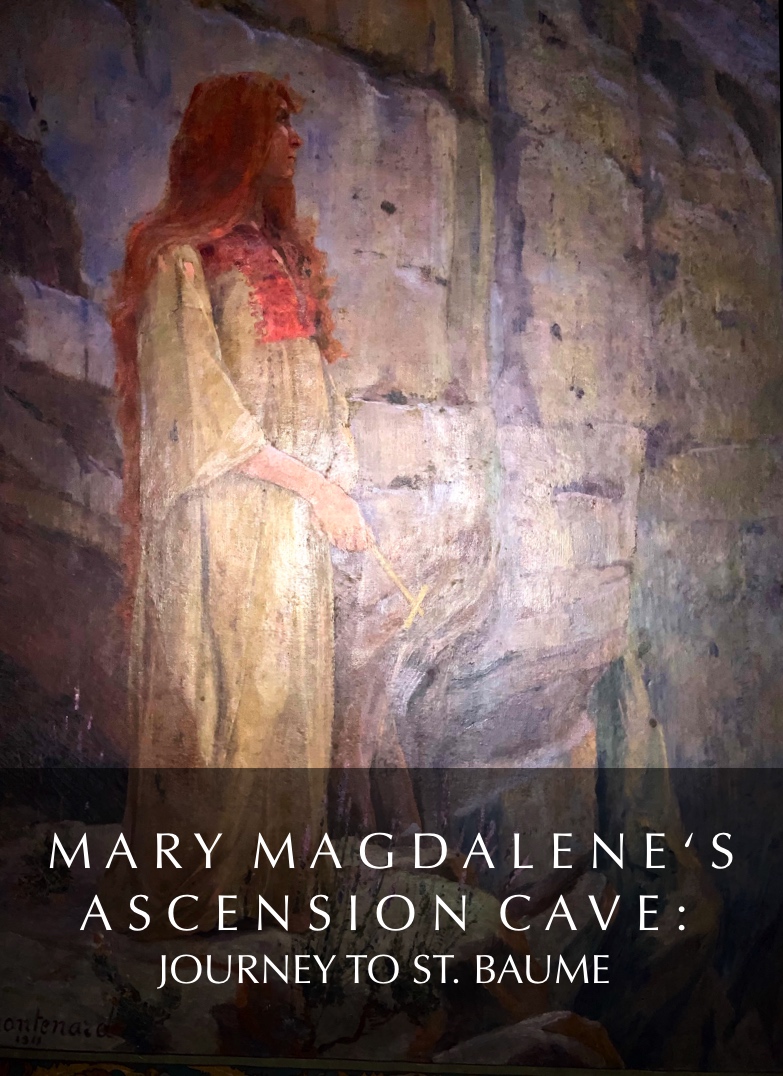
According to Tradition, after Christ’s resurrection, its first witness, Mary Magdalene, fled to southern France, where she lived as a hermit in a cave / cathedral at Sainte Baume near Aix-en-Provence and regularly ascended to the heavens with the help of angels. This Tradition is considered absolute fact in Provence whose residents consider the cave of Mary Magdalene to be the third most important Christian site after Jerusalem and Magdala. Clare and I made a pilgrimage to this extraordinary portal in September 2019. We will be returning in September 2020 during our Sacred France tour. Here, I will share some reflections on our visit.
As ‘Magdalene’s children’, so to speak, Clare and I went to St. Baume to feel it for ourselves. I have been traveling in the Southern France on the trails of Magdalene’s mysteries since 1996, but, as fate would have it, never made it to St. Baume. I find that being in the right place at the wrong time never works. But, being in the right place at the right time, with the right person, produces a magical experience. Clare has a truly otherworldly way of opening doors and windows that remain hidden for most. There is a Cherokee saying that applies to our marriage, that is: ‘A woman’s highest calling is to lead a man to his soul so as to unite him with his source. A man’s highest calling is to protect women so she is free to walk the earth unharmed’. My soul was waiting for the right time to visit this holy place with the holiest person I know.
Our journey to St. Baume began with two days spent exploring the beautiful seaside fishing village, Saintes Maries-de-la-Mer. The town is named after “the Marys” who accompanied Mary Magdalene, Mary Jacobe and Mary Salome, who were part of the Holy Family and present at the foot of the Cross and who prepared Jesus’s body for his resurrection. According to the Tradition of Provence, Mary Magdalene, Lazarus of Bethany, and Maximinus, one of the Seventy Disciples and some companions, on the run from the Romans from the Holy Land after the Ascension of Christ, traversed the Mediterranean in a frail boat with neither rudder nor mast and, after many days, landed at this propitious place.
In Magdalene’s time, this village provided a safe, and perhaps, secretive, harbor and entry point to St. Baume. Today, it exudes charm and glimmers with sunshine and a festive Spanish vibe. Its magnificent beach draws visitors from all over the world…especially those on the Magdalene trail. Here, also, the French cowboys of the Camargue, the famous local marshland with its black bulls and ancient wild white horses, gather. This Nashville cat felt right at home walking amongst the shops bursting with cowboy hats and boots.
Saintes Marie-de-la-Mer is a place for fun, basking in the sun, and contemplating the Divine Light of Magdalene.
The Church of Saintes Maries-de-la-Mer (above) features a statue of Saint Sara, the daughter of Jesus and Mary Magdalene in its crypt (below).
The statue of Sara, the daughter of Jesus and Mary Magdalene.
After two days at Saintes Maries de-la-Mer we drove north into the Camargue pulled along by the spiritual and geomagnetic lure of the holy cave ahead. On our way out we unexpectedly stopped to see a lone flamingo standing blissfully at peace, sunning itself in a marsh beside the highway. Saintes Maries-de-la-Mer is famous as a sanctuary for these exotic birds who come up from Africa. We were elated to finally see one!
Our drive from the Camargue took us through a flat terrain with ranch after ranch of white horses…the perfect gateway to the rolling countryside of Aix-en-Provence. At mid-morning we arrived at Sainte-Baume.
THE HOLY CAVE
Magdalene is said to have retired to the cave in Sainte-Baume (“Holy Cave”, baumo in Provençal), where she gave herself up to a life of prayer and contemplation. The natural grotto dug by erosion is one of the most ancient, and has become one of the most important, pilgrimage places in the Christian world. It is thought that she lived here thirty years. Like the beloved in the Song of Songs, the “dove hidden in the clefts of the rock, in the hiding places on the mountainside”, she devoted herself to prayer and solitary contemplation.
Dante Rosetti’s “Damsel Of The Sacred Grail” captures Magdalene’s essence.
Magdalene was the first Christian disciple and prophetess. She was the power behind the Christos Revolution. The Gospel of Mary described her initiation into the Merkabah ascension mysteries by the resurrected Jesus. These mysteries focused on the transformation of the human body into a being of light in preparation for advancing or ascending to God’s Throne, the Merkabah. Having come from Magdala, where these mysteries were well known, she was eminently prepared to receive them.
At St. Baume, Magdalene used her Merkabah training to ascend.
THE BIG WHITE ROCK
The first thing one notices about Saint Baume is that it is a geologic curiosity: its a rocky white bar, about twelve kilometers long, that emerged from the seabed during the secondary era and its forest, protected by the cliff, is a “relic” of the one which covered the Provence at the end of the tertian era. It is A N C I E N T.
The white bar of St. Baume.
Magdalene’s Cave blends with the rock. It sits about half way up the sheer cliff.
One cannot help but wonder, “why not this place”? when approaching. It was obviously chosen due to something about the geology of the area…and you can feel it as you get close.
One also wonders how or why the ‘relic’ forest is there. Actually, the Dominican brothers who tend it think it is there for Magdalene.
This walk is like a portal to another time, which may explain why the path is called “Merlin”.
The ascent to the cave is a 45 minute huffing, puffing, walking and stopping meditation. Silence is requested and it accentuates the sacredness of the experience. We are, indeed, on holy ground in this magnificent and ancient forest. Hickory, oak, linden and European yew (some claim a few of the trees are over 1,000 years old!) speak to us in the silence.
At last, we arrive at the last 150 steps to the chapel. 150 represents the Psalms of David and the 150 Hail Marys of the Rosary. Personally, I think there are actually 153 steps. 153 is the number of the Magdalene.
Sshh. Secrets ahead, signals the Dominican at the top of the stairs.
The view from Magdalene’s cave is breathtaking, especially under a canopy of soft pink / purple clouds.
Clare at the entrance to Magdalene’s cave / cathedral.
Today’s visitor finds the cave is now a functioning chapel with votive candles flickering in unison, their flames reaching up to the Magdalene. None of the Dominican monks who tend this sacred space were around. We had the cave to ourselves…in silence. Later, I learned this is an extraodinary occurrence as the cave is most often filled with visitors from all over the world.
The altar.
The chapel is massive, seating around 1,000 people. It is a stage for connection to the Divine. A few chants from Clare brought it to life. Suddenly, the cathedral is humming. Its walls coming alive.
For a moment I could imagine (or recall) what it must have looked when Magdalene was here. She must have covered the stone with rich and warm fabrics and illuminated it with masses of candles, in addition to her own light. Assuredly, her chanting, and that of her children, still rings in the stone. The immortal atoms of her oils still anoint our breath. Like the Tibetan term or hidden treasure tradition, in which relics and teachings are hidden in rocks for future recovery, this is a repository of her ascension knowledge. It literally rings of it!
Looking out toward the valley from inside the cave.
Magdalene reclining on a rock.
Magdalene with a rose left by an adoring visitor.
Magdalene ascending.
A lone flame illuminates the Illuminator.
Behind, or near, the enchanting statues of Mary Magdalene are entrances to passages into the cliff. Clare kept wanting to go further into the tunnels. During our past journeys to Southern France we have become enchanted by the cave churches and the allure of legends that say these were portals to places on, or in, the earth, and beyond.
Perhaps no one captured the possible goings at Magdalene’s cave better than the renowned English Spiritualist, Emma Hardinge Britten. In her her 1897 book Ghost Land: Researches into the Mysteries of Occultism, she eloquently writes about hidden tunnels purportedly leading to an underground city at the Kailasa temple in India, where Jesus is reputed to have lived. Kailasa is thought of as the Throne of the Gods. Beneath the Kailasa Temple are huge subterranean cavern-temples and tunnels beneath the surface — all hewn out of rock. Some believe it is a gateway to Shambhala, or even Shambhala itself.
I know. She’s writing about a cave beneath India most vaunted temple. However, reading these lines while contemplating the mysteries of Magdalene’s cave fires my imagination, and I know, it will fire yours, too:
At the small opening of the horse-shoe was a second cavern, hewn out of the solid rock, and so designed as to form an immense raised platform or stage, on the floor of which was spread a carpet of grassy turf, or an imitation so finely executed that the difference could not be detected. A pair of gigantic sphinxes supported either side of this noble rostrum, and an immense image of the winged bull of Mineveh was suspended, in all probability by magnetic force, in mid-air, between the high vaulted roof and the grassy carpet beneath. The walls and ceiling of this huge, cavernous stage, were otherwise destitute of adornment. A golden hand held a scroll suspended over the auditorium, inscribed with a word in Arabic which corresponds to Neophytes, whilst a similar hand and scroll appeared over the cornice which served as proscenium to the stage, with the Arabic inscription signifying Hierophants. Ranged in a semicircle midway on the platform were seven tripods supporting braziers, from which ascended colored flames and wreaths of deliciously perfumed vapors, whose intoxicating odors filled the temple. Behind each tripod, seated on thrones fashioned of burnished silver, so as to represent a glittering star, were seven dark-robed figures, whose masked faces and shrouded forms left no opportunity of judging of their sex or semblance.
No legend says Magdalene was alone in the cave at St. Baume. What if she wasn’t? She assuredly had an entourage. What if her cave functioned similarly to the cave at Kailasa? What if it was like Kailasa, a place where humans raised themselves to the level of the divine and where the divine could meet the human world?
THE ASCENSION / ECSTASY OF MARY MAGALENE
Let us take a look now at some of the extraordinary images of the Ecstasy or Ascension of Mary Magdalene.
Inspiration for these paintings comes from Jacobus de Voragine’s book, The Golden Legend, in which it is written:
“… The saint, desiring to contemplate celestial things, withdrew into a mountain cave which had been prepared by the angels’ hands and there she remained for thirty years unknown to everyone…”
Each day, the angels lifted her into the skies and for an hour she heard the music; after which, replete with this delicious meal, re-descended into her cave, and had not the slightest need of body ailments….”
The Golden Legend is clearly telling us there is something special about this cave (like the cave of Kailasa). It was prepared ‘by angels hands’.
The angels lift Magdalene in a spiraling vortex. It is safe to say that this ‘flight’ is not to a physical destination. Rather, it is to a metaphysical one.
Angels bring communion to Mary Magdalene.
The setting for Peter Paul Ruben’s painting of the Magadalene’s Ecstasy is a rocky ledge at the mouth of a cave…St. Baume.
Rubens, Ecstasy of Mary Magdalene.
Rubens conveys an extraordinary secret and deep mysticism in this painting. Note the empty jar beside Mary Magdalene. Is this the source of her ecstasy? It most certainly is. I discuss it further here and here.
Her face and upper body have been lit-up by a shaft of light that emerges from heaven in the upper right. Look at the expression on Magdalene’s face. She appears to be in a trance-like state. Actually, she is out of her body. She is in full bliss. Connected to the heavenly realms.
The ancient Greek ancestor of our word ecstasy is ekstasis, formed of ek (outside or beyond) and stasis (“standing, stature”).
The Oxford English Dictionary records ekstasis transforming in meaning in “late” Greek, becoming “withdrawal of the soul from the body, mystic or prophetic trance.” Particularly among medical writers, “ecstasy” was used interchangeably with “trance.”
The art historian Baudouin points out that the ecstasy which transfigures Mary Magdaleneis surprisingly reminiscent of the detailed descriptions of the ecstacy to the Spanish saint, Teresa of Avila.
‘To love God with all your soul’,” wrote Paramahansa Yogananda, “means to enter the state of superconscious ecstasy, direct perception of the soul and its oneness with God.
It is the realization of the soul as the reflection of God, the soul’s connection with the consciousness of God.
To love God with all the soul requires the complete stillness of transcendent interiorization.
This state of being, we are assured, was attained by Magdalene as she completed her ascension.
THE HAIR
According to legend, when the repentant Mary Magdalene lived in the cave she was clothed only by her hair. This unusual nude figure represents Mary Magdalene as a mystic ascetic with her trademark unusually long hair. What is the meaning of this hair?
The statue appeared on the German art market in the 19th century and was purchased by the Louvre in 1902.
We see the same long hair motif in these scenes where Mary Magdalene is ascending to heaven in the company of angels.
The angels form a twirling whirlwind or vortex around her hair covered body as they lift her into the heavens.
Perhaps the most striking example of the Magdalene covered with hair is found in Botticelli’s “The Trinity with Saints” altarpiece from 1491.
This painting is part of an altarpiece commissioned for a convent for repentant prostitutes, Sant’ Elisabetta delle Convertite in Florence. Today, it is in London’s Courtauld Gallery.
Alessandro di Mariano Filipepi Botticelli (1444-1510), Trinity with Saint Mary Magdalen and Saint John the Baptist, Archangel Raphael and Tobias, 1491-1494, @The Samuel Courtauld Trust, The Courtauld Gallery, London.
In the center is a vision of the Trinity: God the father, a dove symbolizing the Holy Spirit and Christ on the cross.
Flanking Christ are John the Baptist, patron saint of Florence, and Mary Magdalene, patroness of the convent.
Mary is clothed by her hair and John wears fur, recalling the time both saints spent in the wilderness, says the Courtauld Gallery website.
Taddeo Crivelli shows the Magdalene with her hair covered body, and ascending upon a whirling vortex composed of angels. The cloud is, of course, a reference to the Merkabah throne.
Taddeo Crivelli. Magdalene ascending.
Be warned, however: not all hairy ladies are Mary Magdalene. Some, like the one below by Giotto from Assisi, are Mary of Egypt, who lived during the 4th century, and became the patron saint of penitents.
In early 1500s, German artists produced a series of depictions of the ecstacy or ascension of Mary Magdalene covered with hair.
The Nuremberg Chronicle.
Antonio del Pollaiolo, Assumption of Mary Magdalene, ca.1460, Museo del Pollaiolo, Staggia Senese.
Other versions show her covered with feathers that resemble fur.

Miniature accompanying prayers relating to Mary Magdalene, from the Sforza Hours, Add MS 34294, f. 211v
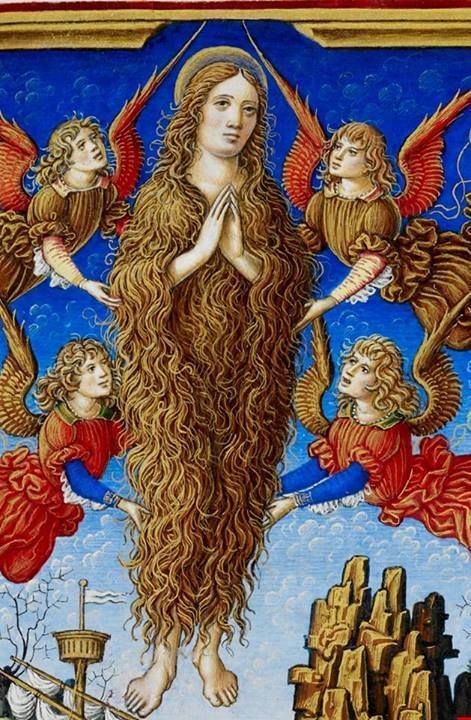
Attavante degli Attavanti and workshop, Mary Magdalene in “Horae ad usum Ecclesiae Romanae”, ca. 1492, Royal Castle in Warsaw
It is believed that this practice arose from medieval dramas and mystery plays in which the actors portraying angels wore garments covered with feathers to emphasize their power of flight. Feather tights is the name given by art historians to this form of body suit. Mary Magdalene’s hair suit is another form of the feather suit. Covering her body in hair symbolizes Magdalene’s abilty to traverse different planes of existence (via the ‘food’ of the angels). Could the hair and fur actually be a reference to the ascension suit? It appears so.
An angel in feather tights. In order to ascend we must be dressed appropriately.
Would be way too over the top to portray the Magdalene with feathers covering her body?
Ptah, the Egyptian god of ascension with his feathered ascension suit.
Vital insight into this question comes from Egyptian images of Ptah, the god of smithcraft and ascension, who is also shown with their body covered with feathers or wearing a feather suit of many colors. Ptah is, undoubtedly, the original purveyor of the feather suit or ascension suit.
Ptah’s ‘ascension suit’ is feathered because he traverses dimensions.
Could there be a deep connection between Magdalene’s suit, the feathered ascension suit of Ptah?
In my view, there most definitely is. They symbolize exactly the same state of being. Perhaps remembering / honoring this connection is the reason for my visit to Magdalene’s ascension cave.
Memories of our pilgrimage to St. Baume will long live in Clare and me. The beauty of the place. The rarefied air. The vibration of Magdalene’s chants ringing in the stone. We invite you to return with us to experience the glorious mysteries of the Magdalene’s ascension cave with us in September 2020.
10 Comments
-
I was near tears as I learned of this through your writing . This leads to home. God Bless You.
-
Beautiful article.. Thank you for all the lovely art.
Many Blessings,
gwen
p.s. I copied the address of my youtube channel from 12 years ago for my website here. (I can no longer can access..) Thought you might like the videos.. -
A lovely read on a sunny Sunday afternoon. Wonderful as always!
-
Lovely article in every way, thank you.
-
I really like this very early image of Mary because of it’s simplicity, she even appears to have her famed red hair here.
Blessings.
https://images.app.goo.gl/pFh4YJZAKaSdcKAs9 -
I’m really enjoying your program on Gaia, which has led me here. Your knowledge about Mary, and so many others is simply breathtaking. Beautiful you are. Namaste.
-
Unbelievable what you have done for so many! Blessings be upon you.
-
If you can get the book Alchemist’s Handbook to the Glia Brain and Higher Consciousness by Rev Mary Hardy with assistance from Rozlynn Orr and the sisterhood of the Emerald Fire, it will explains a lot more info. The canister Mary had held Essential Oils. After arriving in France they set up schools to teach the wisdom of the Magi. Later they were know has the Cathars and were crucified by the Roman Catholic Church for their wisdom. The Inquisition or the Albigensian crusade was created to destroy the Cathars in the early 1200’s. The last group was destroyed at Montsegur in 1244. Look up the Cathars Creed. Look up the Holy Grail Vortex.
-
good comment Deb!
I study the Cathars for many years . I know the work and books from Mary Hardy. Very Nice.
I also studied and read many books from Arthur Guirdham where he writes about group reincarnation of the Cathars in Lake District
Also very special. The energy of Lake district and the Cathar Region around Carcasonne etc have a lot ‘in common’ ( when you feel or read the Energy and beauty of the landscapes ) -
Catharism was, as far as we can know — I have seen no reliable evidence to the contrary — extreme Gnostic Dualism, hence a distortion of the true way and doctrine of Jesus Christ. Sure, there have been errors in the Papacy also, but no crime of Rome justifies the errors of the Cathars; truth is truth, error is error; there IS such a thing as real heresy, if we accept that Jesus Christ was the Truth. (And if we don’t, what have we to do with St. Mary Magdalene, His most devoted follower and witness of His death and resurrection?) And the error of the Cathars (as we know them) lay precisely in rejection of the CROSS, wanting transcendence or liberation without the heavy Incarnation, Crucifixion, descent into hell, etc, that is the way Jesus showed us to heal humanity — rejection of the CROSS, with the entire chain of consequences and implications that ensues. This dissociating route of escape espoused by the dualistic gnostic heresies is a Luciferic temptation. Lucifer is an ingenious manipulator of esoterism in order to subvert the true Christian way, and this seems to be what happened in the Catharism, as with the other gnostic heresies. (This is not to say that ‘he’ has not manipulated the Orthodox/Catholic Church also from within.)
Catharism was not of the true Christian Grail Mystery (regarding that, see Waite’s opinion in ‘Hidden Church of the Holy Grail’, one I can concur with; for example, they rejected the Eucharistic Mystery), nor was it of St. Maria Magdalena. This is a myth in the false sense, unless the historical evidence is totally falsified, but I don’t think it is. The true Christian Grail Tradition (I make that qualification because the ‘Grail ‘ has been associated with so many different things), would only be the complete esoteric knowledge of the very same mystery that Jesus Christ revealed to the Church and that is also expressed in its orthodox symbolism, doctrine and ritual — it cannot actually contradict this ‘outer’ form of the revelation. The fact that the Cathars weren’t able (or willing) to understand the profound meaning of orthodox Christian symbolism — take only the Cross or the Eucharist for example — but rather rejected even these (quite apart from the question of hierarchical power and authority of the Papacy), shows their ignorance of the true esoteric mystery of the Church, which is the same as the true mystery of the Grail.
That said, there were many good Cathar followers, and I admire their courage. Many of them obviously lived good Christian lives, despite these confusions. I have much respect for these people, but I believe they may have been manipulated by a deception no better than the Rome that they rejected. As a final note let me also say that much of that world is hidden to us, so it is difficult to make a completely fair evaluation. And for that same reason, it is a dangerous trail to take this group as a guiding ideal today.
Peace be with you.
-


